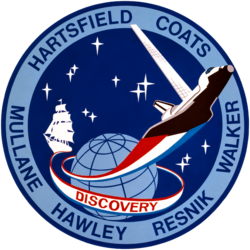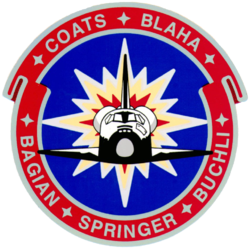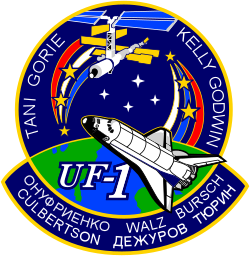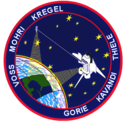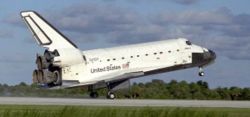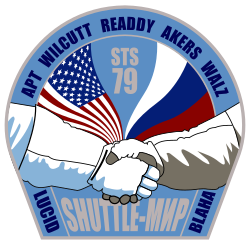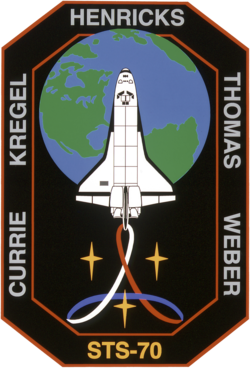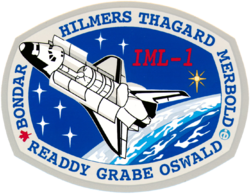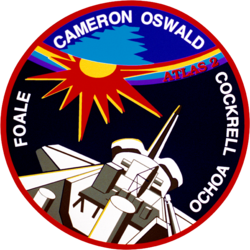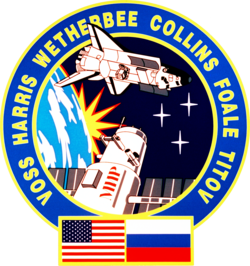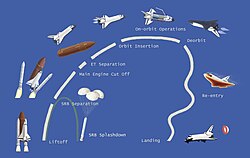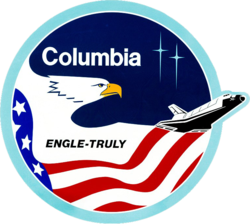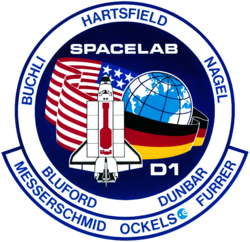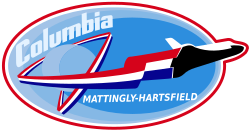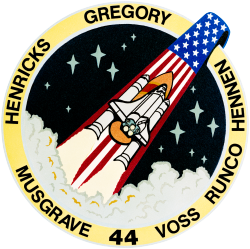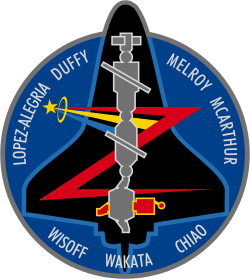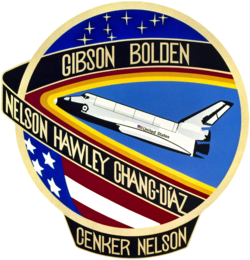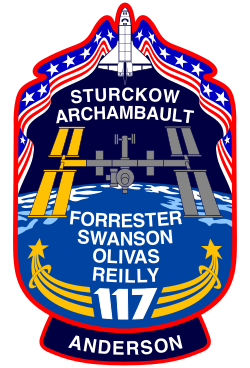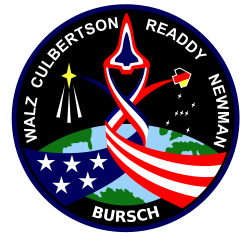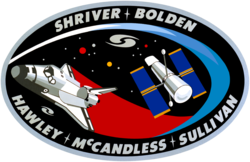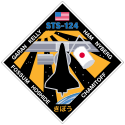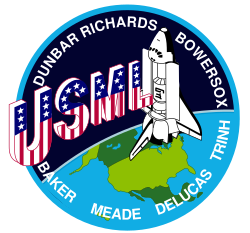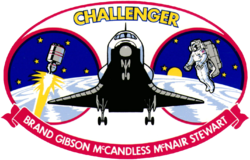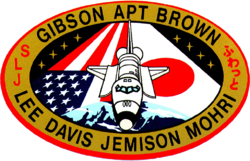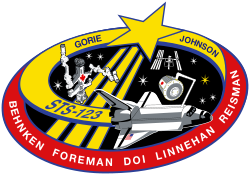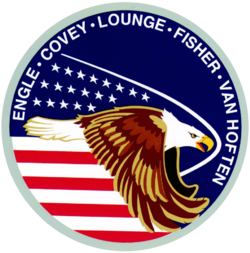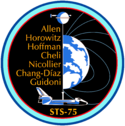Rumfærge-programmet
- Denne side handler om rumfærge-programmet. For informationer om selve fartøjet, se Rumfærge.
Denne artikel behøver tilretning af sproget. Sproget i denne artikel er af lav kvalitet på grund af stavefejl, grammatikfejl, uklare formuleringer eller sin uencyklopædiske stil. (december 2020) (Lær hvordan og hvornår man kan fjerne denne skabelonbesked) |

Rumfærge-programmet var det fjerde bemandede rumfartsprogram, der blev gennemført af den amerikanske rumfartsorganisation NASA. Programmet var aktivt fra 1981 til 2011. Programmets officielle navn, Space Transportation System (STS), blev fastlagt i den oprindelige plan fra 1969 for et system med et genanvendeligt rumfartøj, hvilket var det eneste, der blev finansieret af programmet. Rumfærgeprogrammet blev planlagt under Nixons præsidentperiode og tog sin begyndelse i 1969. Den formelle beslutning om iværksættelse blev truffet den 5. januar 1972.[1] Den første bemandede flyvning med det udviklede rumfartøj, der på dansk blev kaldt rumfærgen, fandt sted med missionen STS-1, der blev opsendt den 12. april 1981.
Rumfærgen blev opsendt lodret og kunne medbringe en last på 22.700 kg, ud over sin besætning med cirka syv astronauter, til lavt jordkredsløb. Under landingen fungerede rumfærgen som et svævefly, der gled ned gennem atmosfæren uden motorkraft og landede på en landingsbane.
Rumfærgen har været det eneste bemandede rumfartøj med vinger, der har opnået kredsløb og landing. Det har også været det eneste bemandede rumfartøj der kan genbruges og har været i kredsløb om jorden flere gange.
De primære missioner for rumfærgen var at transportere store laster til kredsløb (herunder adskillige elementer af Den Internationale Rumstation (ISS), Rumteleskopet Hubble og jupiter-sonden Galileo), at virke som et laboratorium i kredsløb om jorden og stå for servicemissioner til Hubble og besætningsrotation på ISS.
Rumfærgen kunne også indsamle satellitter eller andet fra kredsløb og bringe det tilbage til jorden, men disse muligheder blev sjældent benyttet da opsendelser med rumfærge er så dyre at det for det meste bedre kunne betale sig at opsende en helt ny satellit.
Hvert fartøj blev designet til at skulle holde til 100 opsendelser og dette skulle svare til 10 års brug. Men pga. af omkostninger der var meget højere end forventet har der ikke været nær så mange rumfærgeopsendelser som oprindeligt planlagt.
Programmet har haft i alt fem fartøjer: Columbia (1981-2003), Challenger (1983-1986), Discovery (1984-2011), Atlantis (1985-2011) og Endeavour (1992-2011) [2] plus testfartøjet Enterprise (1977). Den hyppigst opsendte rumfærge er Discovery med 37 opsendelser, den blev opsendt for første gang 30. august 1984.
Den tidligste planlægning af rumfærge-programmet startede i de sene 1960'ere og programmet har domineret NASAs bemandede aktiviteter siden midten af 1970'erne. Ifølge The vision for space exploration skulle rumfærgen bruges til at færdiggøre ISS inden 2010 hvorefter den ville blive pensioneret og skulle afløses af Orion fartøjet, men disse planer blev ændret pga. præsident skift.
I 2009 var det til overvejelse hos den nyvalgte præsident Barack Obama om rumfærge-flyvningerne skulle forlænges yderligere.[3] Der var afsat penge på budgettet til at fuldføre de resterende planlagte flyvninger og i tilfælde af forsinkelser eller andre problemer havde rumfærge-programmet fået et års længere levetid frem til 2011. [4]
Nødsituationer
Under opsendelsen kan en eller flere af rumfærgens tre hovedmotorer svigte:
- T-0: Færgens hovedmotorer tænder 6,6 sekunder før faststofraketterne – hvis computerne finder uregelmæssigheder ved hovedmotorerne, slukker de dem og annullerer faststofraketternes tænding (T=0). Dette er sket fem gange (STS-41-D, STS-51-F, STS-51, STS-55 og STS-68). Hvis først faststofraketterne er blevet tændt må man flyve og vente til de er brændt ud. Det er for risikabelt at bortkaste dem mens de stadig brænder.
- RTLS (Return To Launch Site): Når faststofraketterne brænder ud efter 123 sekunder vender rumfærgen næsen mod Kennedy Rumfartscenteret. Dette vil ske i 35 km højde uden større luftmodstand. De resterende hovedmotorer bruges til at decelerere færgens opnåede hastighed, hvorefter brændstoftanken kastes og færgen svæveflyver. De 37 km til Kennedy Rumfartscenteret tilbagelægges på 25 min.
- TAL (Transoceanic Abort Landing): Ved T+2:30 minutter vil et motorsvigt give færgen en parabelbane der ender i Europa eller Afrika. 45 minutter efter starten vil færgen svævelande i Istres (Frankrig), Rota (Spanien) eller Dakar (Senegal).
- AOA (Abort Once Around ): TAL og ATO overlapper hinanden og i overlappet kan et motorsvigt begrænse færgens muligheder til en enkelt tur rundt om Jorden med landing 90 minutter efter starten. Dette bruges også ved kabinetrykfald, strømsvigt o.lign.
- ATO (Abort To Orbit): Fra T+5:30 minutter kan færgen opnå en minimumshøjde for et stabilt kredsløb. Indtil T+8:30 (Main Engines Cut-Off) vil kredsløbets højde vokse til det når den planlagte højde.
Rumfærgemissioner
Det var oprindelig planlagt at der skulle være rumfærge-afgang en gang om ugen. Rumfærgerne skulle bringe astronauter til en rumstation hvorfra de kunne flyve videre til Månen eller Mars. Rumfærge-missionerne skulle også sætte kommercielle satellitter ud og udføre forskning i rummet. Det var meningen at de store investeringer skulle tjene sig selv ind.
1980'erne
De første fem rumfærgeflyvninger var bemandede testflyvninger med Columbia. På de første missioner var besætningen kun på to astronauter der sad i katapultsæder i tilfælde af en nødsituation i lav højde. Varigheden og antallet af passagerer steg efterhånden som missionerne gik fra testfase til drift.
Opsendelserne sker altid fra Kennedy Space Center (Florida) mens Edwards Air Force Base (Californien) er det sikreste landingssted pga. af de langstrakte udtørrede saltsøer. Rumfærgerne landede derfor i starten på Edwards og blev transporteret tilbage til Kennedy-centeret, hvilket var en stor omkostning. På de senere missioner er det derfor altid Kennedy-centeret der benyttes som landingsbane, medmindre vejret eller andre kritiske forhold ikke tillader det. White Sands Missile Range i New Mexico er den tertiære landingsplads der kun er blevet brugt af STS-3 i 1982. Det er også et enormt område af udtørrede saltsøer, men ved landingen ødelagde gipsstøv nogle af kaklernes overflade.
- 1981

 STS-1 (Varighed: 2 døgn, besætning: 2) Første flyvning med Columbia.
STS-1 (Varighed: 2 døgn, besætning: 2) Første flyvning med Columbia. STS-2 (Varighed: 2 døgn, besætning: 2) Første gang, et bemandet genbrugeligt rumfartøj fløj ud i rummet for anden gang.
STS-2 (Varighed: 2 døgn, besætning: 2) Første gang, et bemandet genbrugeligt rumfartøj fløj ud i rummet for anden gang.- 2 missioner
- 1982
 STS-3 (Varighed: 8 døgn, besætning: 2) Den eksterne tank var ikke længere hvid, for at opnå en vægt formindskning på 375 kg undlod man at male rumfærgen.
STS-3 (Varighed: 8 døgn, besætning: 2) Den eksterne tank var ikke længere hvid, for at opnå en vægt formindskning på 375 kg undlod man at male rumfærgen. STS-4 (Varighed: 7 døgn, besætning: 2) Missionen medbragte det første kommercielle eksperiment og klassificeret militær last for Forsvarsministeriet (USA) (DoD).
STS-4 (Varighed: 7 døgn, besætning: 2) Missionen medbragte det første kommercielle eksperiment og klassificeret militær last for Forsvarsministeriet (USA) (DoD). STS-5 (Varighed: 5 døgn, besætning: 4) Besætningen udvides fra to til fire. Den første planlagte rumvandring i rumfærge-programmet blev aflyst pga. fejl på rumdragten.
STS-5 (Varighed: 5 døgn, besætning: 4) Besætningen udvides fra to til fire. Den første planlagte rumvandring i rumfærge-programmet blev aflyst pga. fejl på rumdragten.- 3 missioner. Total 5
- 1983

 STS-6 (Varighed: 6 døgn, besætning: 4) Første flyvning med Challenger. Første rumvandring i rumfærgeprogrammet udføres. Satte TDRS-1 i kredsløb.
STS-6 (Varighed: 6 døgn, besætning: 4) Første flyvning med Challenger. Første rumvandring i rumfærgeprogrammet udføres. Satte TDRS-1 i kredsløb. STS-7 (Varighed: 6 døgn, besætning: 5) Den første amerikanske rumfærge-mission med en kvindelig astronaut.
STS-7 (Varighed: 6 døgn, besætning: 5) Den første amerikanske rumfærge-mission med en kvindelig astronaut. STS-8 (Varighed: 6 døgn, besætning: 5) Den første opsendelse hvor en rumfærge skulle opsendes om natten.
STS-8 (Varighed: 6 døgn, besætning: 5) Den første opsendelse hvor en rumfærge skulle opsendes om natten. STS-9 (Varighed: 10 døgn, besætning: 6) En tysk astronaut blev den første i rummet fra Den Europæiske Rumorganisation med den første Spacelab.
STS-9 (Varighed: 10 døgn, besætning: 6) En tysk astronaut blev den første i rummet fra Den Europæiske Rumorganisation med den første Spacelab.- 4 missioner. Total 9
- 1984

 STS-41-B (Varighed: 8 døgn, besætning: 5) Første landing på Kennedy Space Center. Ændring af missionskoder.
STS-41-B (Varighed: 8 døgn, besætning: 5) Første landing på Kennedy Space Center. Ændring af missionskoder. STS-41-C (Varighed: 7 døgn, besætning: 5) Medbragte Long Duration Exposure Facility.
STS-41-C (Varighed: 7 døgn, besætning: 5) Medbragte Long Duration Exposure Facility. STS-41-D (Varighed: 6 døgn, besætning: 6) Første flyvning med Discovery.
STS-41-D (Varighed: 6 døgn, besætning: 6) Første flyvning med Discovery. STS-41-G (Varighed: 8 døgn, besætning: 7).
STS-41-G (Varighed: 8 døgn, besætning: 7). STS-51-A (Varighed: 9 døgn, besætning: 5) Satte to satellitter ud og bragte to retur til jorden.
STS-51-A (Varighed: 9 døgn, besætning: 5) Satte to satellitter ud og bragte to retur til jorden.- 5 missioner. Total 14
- 1985

 STS-51-C (Varighed: 3 døgn, besætning: 5) Militær mission for DoD, o-ringsproblem.
STS-51-C (Varighed: 3 døgn, besætning: 5) Militær mission for DoD, o-ringsproblem. STS-51-D (Varighed: 7 døgn, besætning: 7) Medbragte den første rumturist (gratist), den republikanske senator Jake Garn.
STS-51-D (Varighed: 7 døgn, besætning: 7) Medbragte den første rumturist (gratist), den republikanske senator Jake Garn. STS-51-B (Varighed: 7 døgn, besætning: 7) Spacelab-3, syv personer om bord.
STS-51-B (Varighed: 7 døgn, besætning: 7) Spacelab-3, syv personer om bord. STS-51-G (Varighed: 7 døgn, besætning: 7) Medbragte Sultan Salman Al Saud (Saudi-Arabien).
STS-51-G (Varighed: 7 døgn, besætning: 7) Medbragte Sultan Salman Al Saud (Saudi-Arabien). STS-51-F (Varighed: 8 døgn, besætning: 7) Spacelab-2.
STS-51-F (Varighed: 8 døgn, besætning: 7) Spacelab-2. STS-51-I (Varighed: 7 døgn, besætning: 5) Satte tre satellitter ud.
STS-51-I (Varighed: 7 døgn, besætning: 5) Satte tre satellitter ud. STS-51-J (Varighed: 4 døgn, besætning: 5) Første flyvning med Atlantis.
STS-51-J (Varighed: 4 døgn, besætning: 5) Første flyvning med Atlantis. STS-61-A (Varighed: 7 døgn, besætning: 8) Spacelab D1, otte personer om bord.
STS-61-A (Varighed: 7 døgn, besætning: 8) Spacelab D1, otte personer om bord. STS-61-B (Varighed: 7 døgn, besætning: 7) Satte tre satellitter ud.
STS-61-B (Varighed: 7 døgn, besætning: 7) Satte tre satellitter ud.- 9 missioner. Total 23
- 1986

 STS-61-C (Varighed: 6 døgn, besætning: 7) Medbragte den republikanske senator Bill Nelson.
STS-61-C (Varighed: 6 døgn, besætning: 7) Medbragte den republikanske senator Bill Nelson. STS-51-L (Varighed: 73 sekunder, besætning: 7) Challenger-ulykken. Medbragte skolelæreren Christa McAuliffe, alle syv personer om bord omkom.
STS-51-L (Varighed: 73 sekunder, besætning: 7) Challenger-ulykken. Medbragte skolelæreren Christa McAuliffe, alle syv personer om bord omkom.- 2 missioner. Total 25
- 1988
 STS-26 (Varighed: 4 døgn, besætning: 5) "Return to flight", genoptagelse af rumfærgeflyvningen efter to års pause. Satte TDRS-3 i kredsløb.
STS-26 (Varighed: 4 døgn, besætning: 5) "Return to flight", genoptagelse af rumfærgeflyvningen efter to års pause. Satte TDRS-3 i kredsløb. STS-27 (Varighed: 5 døgn, besætning: 5) Militær mission for DoD. Stor skade på varmeskjold.
STS-27 (Varighed: 5 døgn, besætning: 5) Militær mission for DoD. Stor skade på varmeskjold.- 2 missioner. Total 27
- 1989
 STS-29 (Varighed: 5 døgn, besætning: 5) Satte TDRS-4 i kredsløb.
STS-29 (Varighed: 5 døgn, besætning: 5) Satte TDRS-4 i kredsløb. STS-30 (Varighed: 4 døgn, besætning: 5) Venus-sonden Magellan.
STS-30 (Varighed: 4 døgn, besætning: 5) Venus-sonden Magellan. STS-28 (Varighed: 5 døgn, besætning: 5) Militær mission for DoD. Usædvanlig varme på varmeskjold.
STS-28 (Varighed: 5 døgn, besætning: 5) Militær mission for DoD. Usædvanlig varme på varmeskjold. STS-34 (Varighed: 5 døgn, besætning: 5) Galileo-sonden opsendt.
STS-34 (Varighed: 5 døgn, besætning: 5) Galileo-sonden opsendt. STS-33 (Varighed: 5 døgn, besætning: 5) Militær mission for DoD.
STS-33 (Varighed: 5 døgn, besætning: 5) Militær mission for DoD.- 5 missioner. Total 32
1990'erne
Mange ændringer i programmet efter Challenger-ulykken, nødudgang på rampe, tilbagevenden til de gamle missionskoder. Man vendte i en periode tilbage til at benytte Edwards som landingsbane.
- 1990

 STS-32 (Varighed: 10 døgn, besætning: 5) Long Duration Exposure Facility retur til jorden.
STS-32 (Varighed: 10 døgn, besætning: 5) Long Duration Exposure Facility retur til jorden. STS-36 (Varighed: 4 døgn, besætning: 5) Militær mission for DoD. Noget skade på varmeskjold.
STS-36 (Varighed: 4 døgn, besætning: 5) Militær mission for DoD. Noget skade på varmeskjold. STS-31 (Varighed: 5 døgn, besætning: 5) Hubble-rumteleskopet opsendt.
STS-31 (Varighed: 5 døgn, besætning: 5) Hubble-rumteleskopet opsendt. STS-41 (Varighed: 4 døgn, besætning: 5) Ulysses sonden.
STS-41 (Varighed: 4 døgn, besætning: 5) Ulysses sonden. STS-38 (Varighed: 5 døgn, besætning: 5) Militær mission for DoD. Lander igen på Kennedy Space Center for første gang efter Challenger-ulykken.
STS-38 (Varighed: 5 døgn, besætning: 5) Militær mission for DoD. Lander igen på Kennedy Space Center for første gang efter Challenger-ulykken. STS-35 (Varighed: 9 døgn, besætning: 7) ASTRO-1.
STS-35 (Varighed: 9 døgn, besætning: 7) ASTRO-1.- 6 missioner. Total 38
- 1991
 STS-37 (Varighed: 6 døgn, besætning: 5) Compton Gamma Ray Observatory (CGRO).
STS-37 (Varighed: 6 døgn, besætning: 5) Compton Gamma Ray Observatory (CGRO). STS-39 (Varighed: 8 døgn, besætning: 7) Militær mission for DoD.
STS-39 (Varighed: 8 døgn, besætning: 7) Militær mission for DoD. STS-40 (Varighed: 9 døgn, besætning: 7) Spacelab (SLS-1).
STS-40 (Varighed: 9 døgn, besætning: 7) Spacelab (SLS-1). STS-43 (Varighed: 9 døgn, besætning: 5) TDRS-5.
STS-43 (Varighed: 9 døgn, besætning: 5) TDRS-5. STS-48 (Varighed: 5 døgn, besætning: 5) Upper Atmosphere Research Satellite (UARS).
STS-48 (Varighed: 5 døgn, besætning: 5) Upper Atmosphere Research Satellite (UARS). STS-44 (Varighed: 7 døgn, besætning: 6) Militær mission for DoD.
STS-44 (Varighed: 7 døgn, besætning: 6) Militær mission for DoD.- 6 missioner. Total 44
- 1992

 STS-42 (Varighed: 8 døgn, besætning: 7) International Microgravity Laboratory-1 (Spacelab).
STS-42 (Varighed: 8 døgn, besætning: 7) International Microgravity Laboratory-1 (Spacelab). STS-45 (Varighed: 9 døgn, besætning: 7) ATLAS-1 (Spacelab).
STS-45 (Varighed: 9 døgn, besætning: 7) ATLAS-1 (Spacelab). STS-49 (Varighed: 9 døgn, besætning: 7) INTELSAT VI (F-3) satellit. Første flyvning med Endeavour.
STS-49 (Varighed: 9 døgn, besætning: 7) INTELSAT VI (F-3) satellit. Første flyvning med Endeavour. STS-50 (Varighed: 14 døgn, besætning: 7) United States Microgravity Laboratory-I (Spacelab).
STS-50 (Varighed: 14 døgn, besætning: 7) United States Microgravity Laboratory-I (Spacelab). STS-46 (Varighed: 8 døgn, besætning: 7) ESA og fælles NASA/Italiensk satellitter i kredsløb.
STS-46 (Varighed: 8 døgn, besætning: 7) ESA og fælles NASA/Italiensk satellitter i kredsløb. STS-47 (Varighed: 8 døgn, besætning: 7)Fælles NASA/NASDA projekt Spacelab-J.
STS-47 (Varighed: 8 døgn, besætning: 7)Fælles NASA/NASDA projekt Spacelab-J. STS-52 (Varighed: 10 døgn, besætning: 6) Medbragte italiensk, fransk, europæisk og amerikansk udstyr.
STS-52 (Varighed: 10 døgn, besætning: 6) Medbragte italiensk, fransk, europæisk og amerikansk udstyr. STS-53 (Varighed: 7 døgn, besætning: 5) Militær mission for DoD.
STS-53 (Varighed: 7 døgn, besætning: 5) Militær mission for DoD.- 8 missioner. Total 52
- 1993
 STS-54 (Varighed: 6 døgn, besætning: 7) TDRS-6.
STS-54 (Varighed: 6 døgn, besætning: 7) TDRS-6. STS-56 (Varighed: 9 døgn, besætning: 5) ATLAS-2.
STS-56 (Varighed: 9 døgn, besætning: 5) ATLAS-2. STS-55 (Varighed: 10 døgn, besætning: 7) Spacelab.
STS-55 (Varighed: 10 døgn, besætning: 7) Spacelab. STS-57 (Varighed: 10 døgn, besætning: 6) Spacehab.
STS-57 (Varighed: 10 døgn, besætning: 6) Spacehab. STS-51 (Varighed: 10 døgn, besætning: 5) Satellit.
STS-51 (Varighed: 10 døgn, besætning: 5) Satellit. STS-58 (Varighed: 14 døgn, besætning: 7) Spacelab.
STS-58 (Varighed: 14 døgn, besætning: 7) Spacelab. STS-61 (Varighed: 11 døgn, besætning: 7) Hubble-mission (SM 1).
STS-61 (Varighed: 11 døgn, besætning: 7) Hubble-mission (SM 1).- 7 missioner. Total 59
- 1994
 STS-60 (Varighed: 8 døgn, besætning: 6) Første mission i Rumfærge-Mir-programmet. Om bord var den sovjetisk/russisk kosmonaut Sergej Krikaljov.
STS-60 (Varighed: 8 døgn, besætning: 6) Første mission i Rumfærge-Mir-programmet. Om bord var den sovjetisk/russisk kosmonaut Sergej Krikaljov. STS-62 (Varighed: 14 døgn, besætning: 5) Discovery Channel, observation af astronauter på langtidsophold i rummet.
STS-62 (Varighed: 14 døgn, besætning: 5) Discovery Channel, observation af astronauter på langtidsophold i rummet. STS-59 (Varighed: 11 døgn, besætning: 6) Discovery Channel.
STS-59 (Varighed: 11 døgn, besætning: 6) Discovery Channel. STS-65 (Varighed: 15 døgn, besætning: 8) Spacelab (SL).
STS-65 (Varighed: 15 døgn, besætning: 8) Spacelab (SL). STS-64 (Varighed: 11 døgn, besætning: 6) LIDAR In-Space Technology Experiment (LITE).
STS-64 (Varighed: 11 døgn, besætning: 6) LIDAR In-Space Technology Experiment (LITE). STS-68 (Varighed: 11 døgn, besætning: 6) Space Radar Laboratory (SRL).
STS-68 (Varighed: 11 døgn, besætning: 6) Space Radar Laboratory (SRL). STS-66 (Varighed: 11 døgn, besætning: 6) ATLAS 3 (Spacelab).
STS-66 (Varighed: 11 døgn, besætning: 6) ATLAS 3 (Spacelab).- 7 missioner. Total 66
- 1995
 STS-63 (Varighed: 8 døgn, besætning: 6) Første flyvning til Mir (Rumfærge-Mir-programmet).
STS-63 (Varighed: 8 døgn, besætning: 6) Første flyvning til Mir (Rumfærge-Mir-programmet). STS-67 (Varighed: 17 døgn, besætning: 7) Astro-2 (Spacelab).
STS-67 (Varighed: 17 døgn, besætning: 7) Astro-2 (Spacelab). STS-71 (Varighed: 10 døgn, besætning: 7/8) Det var den første mission hvor en rumfærge lagde til Mir. (Rumfærge-Mir-programmet), Mir besætningsskift.
STS-71 (Varighed: 10 døgn, besætning: 7/8) Det var den første mission hvor en rumfærge lagde til Mir. (Rumfærge-Mir-programmet), Mir besætningsskift. STS-70 (Varighed: 9 døgn, besætning: 5) TDRS-7.
STS-70 (Varighed: 9 døgn, besætning: 5) TDRS-7. STS-69 (Varighed: 11 døgn, besætning: 5) Wake Shield Facility (WSF) satellit.
STS-69 (Varighed: 11 døgn, besætning: 5) Wake Shield Facility (WSF) satellit. STS-73 (Varighed: 16 døgn, besætning: 7) Spacelab (USML-2).
STS-73 (Varighed: 16 døgn, besætning: 7) Spacelab (USML-2). STS-74 (Varighed: 8 døgn, besætning: 5) Fjerde mission i Rumfærge-Mir-programmet og anden mission hvor en rumfærge lagde til Mir.
STS-74 (Varighed: 8 døgn, besætning: 5) Fjerde mission i Rumfærge-Mir-programmet og anden mission hvor en rumfærge lagde til Mir.- 7 missioner. Total 73
- 1996
 STS-72 (Varighed: 9 døgn, besætning: 6) Space Flyer Unit (SFU)..
STS-72 (Varighed: 9 døgn, besætning: 6) Space Flyer Unit (SFU).. STS-75 (Varighed: 16 døgn, besætning: 7) Tethered Satellite System Reflight (TSS-1R).
STS-75 (Varighed: 16 døgn, besætning: 7) Tethered Satellite System Reflight (TSS-1R). STS-76 (Varighed: 9 døgn, besætning: 6/5) Mission i Rumfærge-Mir-programmet, og Mir besætningsskift.
STS-76 (Varighed: 9 døgn, besætning: 6/5) Mission i Rumfærge-Mir-programmet, og Mir besætningsskift. STS-77 (Varighed: 10 døgn, besætning: 6) Spacehab 4.
STS-77 (Varighed: 10 døgn, besætning: 6) Spacehab 4. STS-78 (Varighed: 17 døgn, besætning: 7) Klargøring af ISS.
STS-78 (Varighed: 17 døgn, besætning: 7) Klargøring af ISS. STS-79 (Varighed: 10 døgn, besætning: 6/7) Fjerde mission i Rumfærge-Mir-programmet, Mir besætningsskift.
STS-79 (Varighed: 10 døgn, besætning: 6/7) Fjerde mission i Rumfærge-Mir-programmet, Mir besætningsskift. STS-80 (Varighed: 18 døgn, besætning: 5) en hel del satellitter og eksperimenter.
STS-80 (Varighed: 18 døgn, besætning: 5) en hel del satellitter og eksperimenter.- 7 missioner. Total 80
- 1997
 STS-81 (Varighed: 10 døgn, besætning: 6) Mission i Rumfærge-Mir-programmet.
STS-81 (Varighed: 10 døgn, besætning: 6) Mission i Rumfærge-Mir-programmet. STS-82 (Varighed: 10 døgn, besætning: 7) Hubble-mission (SM 2).
STS-82 (Varighed: 10 døgn, besætning: 7) Hubble-mission (SM 2). STS-83 (Varighed: 4 døgn, besætning: 7) Microgravity Science Laboratory (MSL) mission (Spacelab), missionen var planlagt til 15 døgns varighed, men blev afkortet pga. at tekniske problemer.
STS-83 (Varighed: 4 døgn, besætning: 7) Microgravity Science Laboratory (MSL) mission (Spacelab), missionen var planlagt til 15 døgns varighed, men blev afkortet pga. at tekniske problemer. STS-84 (Varighed: 9 døgn, besætning: 7/7) Mission i Rumfærge-Mir-programmet, Mir besætningsskift.
STS-84 (Varighed: 9 døgn, besætning: 7/7) Mission i Rumfærge-Mir-programmet, Mir besætningsskift. STS-94 (Varighed: 16 døgn, besætning: 7) Microgravity Science Laboratory (MSL) mission (Spacelab).
STS-94 (Varighed: 16 døgn, besætning: 7) Microgravity Science Laboratory (MSL) mission (Spacelab). STS-85 (Varighed: 12 døgn, besætning: 6) en hel del satellitter og eksperimenter.
STS-85 (Varighed: 12 døgn, besætning: 6) en hel del satellitter og eksperimenter. STS-86 (Varighed: 11 døgn, besætning: 7/8) Mission i Rumfærge-Mir-programmet, Mir besætningsskift.
STS-86 (Varighed: 11 døgn, besætning: 7/8) Mission i Rumfærge-Mir-programmet, Mir besætningsskift. STS-87 (Varighed: 16 døgn, besætning: 6) United States Microgravity Payload (USMP-4) (Spacelab).
STS-87 (Varighed: 16 døgn, besætning: 6) United States Microgravity Payload (USMP-4) (Spacelab).- 8 missioner. Total 88
- 1998

 STS-89 (Varighed: 9 døgn, besætning: 7/8) Mission i Rumfærge-Mir-programmet, Mir besætningsskift.
STS-89 (Varighed: 9 døgn, besætning: 7/8) Mission i Rumfærge-Mir-programmet, Mir besætningsskift. STS-90 (Varighed: 16 døgn, besætning: 7) Neurolab (Spacelab).
STS-90 (Varighed: 16 døgn, besætning: 7) Neurolab (Spacelab). STS-91 (Varighed: 10 døgn, besætning: 6/7) Sidste mission i Rumfærge-Mir-programmet, Mir besætningsskift.
STS-91 (Varighed: 10 døgn, besætning: 6/7) Sidste mission i Rumfærge-Mir-programmet, Mir besætningsskift. STS-95 (Varighed: 7 døgn, besætning: 7) Den pensionerede astronaut John Glenn var, i en alder af 77 år, med på missionen.
STS-95 (Varighed: 7 døgn, besætning: 7) Den pensionerede astronaut John Glenn var, i en alder af 77 år, med på missionen. STS-88 (Varighed: 12 døgn, besætning: 6) Første flyvning til ISS med Node 1 Unity.
STS-88 (Varighed: 12 døgn, besætning: 6) Første flyvning til ISS med Node 1 Unity.- 5 missioner. Total 93
- 1999
 STS-96 (Varighed: 10 døgn, besætning: 7) Spacehab til ISS.
STS-96 (Varighed: 10 døgn, besætning: 7) Spacehab til ISS. STS-93 (Varighed: 5 døgn, besætning: 5) Chandra X-ray Observatory (rumteleskop), Eileen Collins var den første kvinde som kaptajn.
STS-93 (Varighed: 5 døgn, besætning: 5) Chandra X-ray Observatory (rumteleskop), Eileen Collins var den første kvinde som kaptajn. STS-103 (Varighed: 8 døgn, besætning: 7) Hubble-mission (SM 3).
STS-103 (Varighed: 8 døgn, besætning: 7) Hubble-mission (SM 3).- 3 missioner. Total 96
2000'erne
Missionerne besøger primært Den Internationale Rumstation (ISS) og medbringer forsyninger og hardware til nye udbygninger og installationer. Der kom igen en pause på to år efter Columbia-ulykken i 2003.
- 2000

 STS-99 (Varighed: 11 døgn, besætning: 6) Shuttle Radar Topography Mission (SRTM) projekt.
STS-99 (Varighed: 11 døgn, besætning: 6) Shuttle Radar Topography Mission (SRTM) projekt. STS-101 (Varighed: 10 døgn, besætning: 7) Tredje mission i opbygningen af ISS, rumfærgen flyver for første gang med et nyt moderne cockpit.
STS-101 (Varighed: 10 døgn, besætning: 7) Tredje mission i opbygningen af ISS, rumfærgen flyver for første gang med et nyt moderne cockpit. STS-106 (Varighed: 12 døgn, besætning: 7) Opbygning af ISS medbragte Spacehab-container.
STS-106 (Varighed: 12 døgn, besætning: 7) Opbygning af ISS medbragte Spacehab-container. STS-92 (Varighed: 13 døgn, besætning: 7) Opbygning af ISS.
STS-92 (Varighed: 13 døgn, besætning: 7) Opbygning af ISS. STS-97 (Varighed: 11 døgn, besætning: 5) Første besøg med rumfærgen hvor rumstationen er beboet. Opbygning af ISS med Unity-modulet.
STS-97 (Varighed: 11 døgn, besætning: 5) Første besøg med rumfærgen hvor rumstationen er beboet. Opbygning af ISS med Unity-modulet.- 5 missioner. Total 101
- 2001
 STS-98 (Varighed: 13 døgn, besætning: 5) Destiny-laboratoriemodulet til ISS.
STS-98 (Varighed: 13 døgn, besætning: 5) Destiny-laboratoriemodulet til ISS. STS-102 (Varighed: 13 døgn, besætning: 7/9) Forsyninger i Leonardo-containeren til ISS og ISS besætningsskift.
STS-102 (Varighed: 13 døgn, besætning: 7/9) Forsyninger i Leonardo-containeren til ISS og ISS besætningsskift. STS-100 (Varighed: 12 døgn, besætning: 7) Medbragte robotarmen Canadarm-2 til ISS.
STS-100 (Varighed: 12 døgn, besætning: 7) Medbragte robotarmen Canadarm-2 til ISS. STS-104 (Varighed: 13 døgn, besætning: 5) Medbragte og opsatte en ny luftsluse på ISS.
STS-104 (Varighed: 13 døgn, besætning: 5) Medbragte og opsatte en ny luftsluse på ISS. STS-105 (Varighed: 12 døgn, besætning: 7/7) ISS besætningsskift.
STS-105 (Varighed: 12 døgn, besætning: 7/7) ISS besætningsskift. STS-108 (Varighed: 12 døgn, besætning: 7/7) Forsyninger i Raffaello-containeren til ISS og ISS besætningsskift.
STS-108 (Varighed: 12 døgn, besætning: 7/7) Forsyninger i Raffaello-containeren til ISS og ISS besætningsskift.- 6 missioner. Total 107
- 2002
 STS-109 (Varighed: 11 døgn, besætning: 7) Hubble-mission (SM-4).
STS-109 (Varighed: 11 døgn, besætning: 7) Hubble-mission (SM-4). STS-110 (Varighed: 11 døgn, besætning: 7) Udbygning af ISS.
STS-110 (Varighed: 11 døgn, besætning: 7) Udbygning af ISS. STS-111 (Varighed: 14 døgn, besætning: 7/7) Forsyninger i Leonardo-containeren til ISS og ISS besætningsskift.
STS-111 (Varighed: 14 døgn, besætning: 7/7) Forsyninger i Leonardo-containeren til ISS og ISS besætningsskift. STS-112 (Varighed: 11 døgn, besætning: 6) Udbygning af ISS.
STS-112 (Varighed: 11 døgn, besætning: 6) Udbygning af ISS. STS-113 (Varighed: 14 døgn, besætning: 7/7) Til ISS satte to satellitter i kredsløb og ISS besætningsskift.
STS-113 (Varighed: 14 døgn, besætning: 7/7) Til ISS satte to satellitter i kredsløb og ISS besætningsskift.- 5 missioner. Total 112
- 2003

 STS-107 (Varighed: 16 døgn, besætning: 7) Columbia-ulykken, alle syv om bord omkom.
STS-107 (Varighed: 16 døgn, besætning: 7) Columbia-ulykken, alle syv om bord omkom.- 1 missioner. Total 113
- 2005
 STS-114 (Varighed: 14 døgn, besætning: 7) "Return to flight", genoptagelse af rumfærgeflyvningen efter to års pause.
STS-114 (Varighed: 14 døgn, besætning: 7) "Return to flight", genoptagelse af rumfærgeflyvningen efter to års pause.- 1 missioner. Total 114
- 2006
 STS-121 (Varighed: 13 døgn, besætning: 7) Forsyninger i Leonardo-containeren til ISS.
STS-121 (Varighed: 13 døgn, besætning: 7) Forsyninger i Leonardo-containeren til ISS. STS-115 (Varighed: 12 døgn, besætning: 6) Solcellepaneler til ISS.
STS-115 (Varighed: 12 døgn, besætning: 6) Solcellepaneler til ISS. STS-116 (Varighed: 13 døgn, besætning: 7/7) Medbragte Arne Christer Fuglesang den første skandinav i rummet og ISS besætningsskift.
STS-116 (Varighed: 13 døgn, besætning: 7/7) Medbragte Arne Christer Fuglesang den første skandinav i rummet og ISS besætningsskift.- 3 missioner. Total 117
- 2007

 STS-117 (Varighed: 13 døgn, besætning: 7/7) Solcellepaneler til ISS og ISS besætningsskift.
STS-117 (Varighed: 13 døgn, besætning: 7/7) Solcellepaneler til ISS og ISS besætningsskift. STS-118 (Varighed: 13 døgn, besætning: 7) Medbragte den tidligere skolelærer Barbara Morgan til ISS.
STS-118 (Varighed: 13 døgn, besætning: 7) Medbragte den tidligere skolelærer Barbara Morgan til ISS. STS-120 (Varighed: 15 døgn, besætning: 7/7) Medbragte Harmony til ISS og ISS besætningsskift.
STS-120 (Varighed: 15 døgn, besætning: 7/7) Medbragte Harmony til ISS og ISS besætningsskift.- 3 missioner. Total 120
- 2008
 STS-122 (Varighed: 13 døgn, besætning: 7/7) Columbusmodulet til ISS og ISS besætningsskift.
STS-122 (Varighed: 13 døgn, besætning: 7/7) Columbusmodulet til ISS og ISS besætningsskift. STS-123 (Varighed: 16 døgn, besætning: 7/7) Kibōs logistikmodul (ELM) til ISS og ISS besætningsskift.
STS-123 (Varighed: 16 døgn, besætning: 7/7) Kibōs logistikmodul (ELM) til ISS og ISS besætningsskift. STS-124 (Varighed: 14 døgn, besætning: 7/7) Kibōs bemandede modul (PM) til ISS og ISS besætningsskift.
STS-124 (Varighed: 14 døgn, besætning: 7/7) Kibōs bemandede modul (PM) til ISS og ISS besætningsskift. STS-126 (Varighed: 16 døgn, besætning: 7/7) Forsyninger i Leonardo-containeren til ISS og ISS besætningsskift. Rumstationen udvides til at have plads til en besætning på seks personer.
STS-126 (Varighed: 16 døgn, besætning: 7/7) Forsyninger i Leonardo-containeren til ISS og ISS besætningsskift. Rumstationen udvides til at have plads til en besætning på seks personer.- 4 missioner. Total 124
- 2009
 STS-119 (Varighed: 13 døgn, besætning: 7/7) Solcellepaneler til ISS.
STS-119 (Varighed: 13 døgn, besætning: 7/7) Solcellepaneler til ISS. STS-125 (Varighed: 13 døgn, besætning: 7) Hubble-mission (SM 5).
STS-125 (Varighed: 13 døgn, besætning: 7) Hubble-mission (SM 5). STS-127 (Varighed: 15 døgn, besætning: 7/7) Kibōs instrumentplatform (EF) til ISS
STS-127 (Varighed: 15 døgn, besætning: 7/7) Kibōs instrumentplatform (EF) til ISS STS-128 (Varighed: 13 døgn, besætning: 7/7) Forsyninger i Leonardo-containeren til ISS
STS-128 (Varighed: 13 døgn, besætning: 7/7) Forsyninger i Leonardo-containeren til ISS STS-129 (Varighed: 10 døgn, besætning: 6/7) ExPRESS Logistics Carrier 1 og 2
STS-129 (Varighed: 10 døgn, besætning: 6/7) ExPRESS Logistics Carrier 1 og 2- 5 missioner. Total 129
2010'erne
- 2010
 STS-130 (Varighed: 14 døgn, besætning: 6) Tranquility (3. forbindelsesmodul) og Cupola
STS-130 (Varighed: 14 døgn, besætning: 6) Tranquility (3. forbindelsesmodul) og Cupola STS-131 (Varighed: 15 døgn, besætning: 7) Forsyninger i MPLM-container til ISS
STS-131 (Varighed: 15 døgn, besætning: 7) Forsyninger i MPLM-container til ISS STS-132 (Varighed: 12 døgn, besætning: 6) Integrated Cargo Carrier (ICC) og Rassvet (Mini Research Module -MRM1) til ISS
STS-132 (Varighed: 12 døgn, besætning: 6) Integrated Cargo Carrier (ICC) og Rassvet (Mini Research Module -MRM1) til ISS- 3 missioner. Total 132
- 2011
 STS-133 (Varighed: 13 døgn, besætning: 6) ExPRESS Logistics Carrier 3 og 4 til ISS
STS-133 (Varighed: 13 døgn, besætning: 6) ExPRESS Logistics Carrier 3 og 4 til ISS STS-134 (Varighed: 16 døgn, besætning: 6) Alpha Magnetic Spectrometer til ISS
STS-134 (Varighed: 16 døgn, besætning: 6) Alpha Magnetic Spectrometer til ISS STS-135 (Varighed: 13 døgn, besætning: 4) Oprindelig Standby for STS-134 missionen, sidste rumfærge-mission.
STS-135 (Varighed: 13 døgn, besætning: 4) Oprindelig Standby for STS-134 missionen, sidste rumfærge-mission.- 3 missioner. Total 135
Referencer
- ^ The Space Shuttle Decision:NASA's Search for a Reusable Space Vehicle, kap. 9, nasa.gov
- ^ NASA Orbiter Fleet Arkiveret 17. april 2019 hos Wayback Machine NASA (engelsk)
- ^ Rumfærger på Obamas hasteliste Arkiveret 16. november 2008 hos Wayback Machine Ingeniøren
- ^ Senate budget panel: Shuttle can fly another year Arkiveret 29. april 2009 hos Wayback Machine billnelson.senate.gov (engelsk)
Eksterne henvisninger og kilder
- Space Shuttle -- A Mighty Machine Arkiveret 5. juli 2011 hos Wayback Machine NASA (engelsk)
- Shuttle Missions NASA (engelsk)
- Launch Schedule NASA (engelsk)
- Space Shuttle Flights and ISS Assembly Sequence Arkiveret 7. marts 2009 hos Wayback Machine NASA (engelsk)
- NASA information Arkiveret 30. august 2009 hos Wayback Machine (engelsk)
- Sidste rumfærge af sted Arkiveret 12. januar 2022 hos Wayback Machine Tycho Brahe Planetarium (dansk)
| Foregående: Apollo-programmet | Rumfærge-programmet 1981–2011 | Efterfølgende: Constellation-programmet |
Medier brugt på denne side
STS107-S-001 (May 2001) This is the insignia for w:STS-107, which is a multi-discipline microgravity and Earth science research mission with a multitude of international scientific investigations conducted continuously during the planned 16 days on orbit. The central element of the patch is the microgravity symbol, µg, flowing into the rays of the astronaut symbol. The mission inclination is portrayed by the 39 degree angle of the astronaut symbol to the Earth's horizon. The sunrise is representative of the numerous experiments that are the dawn of a new era for continued microgravity research on the International Space Station and beyond. The breadth of science conducted on this mission will have widespread benefits to life on Earth and our continued exploration of space illustrated by the Earth and stars. The constellation Columba (the dove) was chosen to symbolize peace on Earth and the Space Shuttle Columbia. The seven stars also represent the mission crew members and honor the original astronauts who paved the way to make research in space possible. The Israeli flag is adjacent to the name of the payload specialist who is the first person from that country to fly on the Space Shuttle.
STS-41D Mission Insignia
- The official mission insignia for the 41-D Space Shuttle flight features the Discovery - NASA's third orbital vehicle - as it makes its maiden voyage. The ghost ship represents the orbiter's namesakes which have figured prominently in the history of exploration. The Space Shuttle Discovery heads for new horizons to extend that proud tradition. Surnames for the crewmembers of NASA's eleventh Space Shuttle mission encircle the red, white, and blue scene.
STS-28 mission patch
- The STS-28 insignia was designed by the astronaut crew, who said it portrays the pride the American people have in their manned spaceflight program. It depicts America (the eagle) guiding the space program (the Space Shuttle) safely home from an orbital mission. The view looks south on Baja California and the west coast of the United States as the space travelers re-enter the atmosphere. The hypersonic contrails created by the eagle and Shuttle represent the American flag. The crew called the simple boldness of the design symbolic of America's unfaltering commitment to leadership in the exploration and development of space.
STS-29 Mission Insignia
The STS-29 patch was designed to capture and represent the energy and dynamic nature of this nation's space program as America continues to look to the future. The folded ribbon border, the first of its kind in the Shuttle patch series, gives a sense of three dimensional depth to the emblem. The stylistic orbital maneuvering system (ONS) burn symbolizes the powerful forward momentum of the Shuttle and a continuing determination to explore the frontiers of space. The colors of the U.S. flag are represented in the patch's basic red, white, and blue background. In the border, the seven stars between the STS-29 crew names are a tribute to the crew of Challenger.
STS-5 mission insignia
STS-61 Crew Insignia
STS111-S-001 --- The STS-111 patch symbolizes the hardware, people, and partner nations that contribute to the flight. The Space Shuttle rises on the plume of the Astronaut Office symbol, carrying the Canadian Mobile Base System (MBS) for installation while docked to the International Space Station (ISS). The mission is named UF-2 for ISS Utilization Flight number two. The ISS orbit completes the Astronaut Office symbol and is colored red, white, and blue to represent the flags of the United States, Russia, France, and Costa Rica. The Earth background shows Italy, which contributes the Multi Purpose Logistics Module (MPLM) used on this flight to re-supply ISS. The ten stars in the sky represent the ten astronauts and cosmonauts on orbit during the flight, and the star at the top of the patch represents the Johnson Space Center, in the state of Texas, from which the flight is managed. The names of the STS-111 crew border the upper part of the patch, and the Expedition Five (going up) and Expedition Four (coming down) crews’ names form the bottom of the patch. The NASA insignia design for Shuttle flights is reserved for use by the astronauts and for other official use as the NASA Administrator may authorize. Public availability has been approved only in the forms of illustrations by the various news media. When and if there is any change in this policy, which is not anticipated, the change will be publicly announced.
STS-33 Mission Insignia
STS-51-L INSIGNIA
- Members of the STS-51L crew designed this patch which will represent their participation on NASA's late January 1986 mission aboard the space shuttle Challenger, depicted launching from Florida and soaring into space to carry out a variety of goals. Among the prescribed duties of the five astronauts and two payload specialists will be observation and photography of Halley's Comet, backdropped against the United States flag in the insignia. Surnames of the crew members encircle the scene, with the payload specialists being recognized below. Surname of the first teacher in space, Sharon Christa McAuliffe, is followed by a symbolic apple. Gregory Jarvis, representing Hughes, is the industrial payload specialist for the flight. NASA's crew members are astronauts Francis R. (Dick) Scobee, commander; Michael J. Smith, pilot; and Ronald E. McNair, Ellison S. Onizuka and Judith A. Resnik - all mission specialists.
STS-60 crew patch
- The design of the crew patch for NASA's STS-60 mission depicts the Space Shuttle Discovery's on-orbit configuration. The American and Russian flags symbolize the partnership of the two countries and their crew members taking flight into space together for the first time. The open payload bay contains: the Space Habitation Module (Spacehab), a commercial space laboratory for life and material science experiments; and a Getaway Special Bridge Assembly in the aft section carrying various experiments, both deployable and attached. A scientific experiment to create and measure an ultra-vacuum environment and perform semiconductor material science – the Wake Shield Facility – is shown on the Remote Manipulator System (RMS) prior to deployment.
STS-41 Mission Insignia
This mission patch for mission STS-80 depicts the Space Shuttle Columbia and the two research satellites its crew deployed into the blue field of space. The uppermost satellite is the Orbiting Retrievable Far and Extreme Ultraviolet Spectrograph-Shuttle Pallet Satellite (ORFEUS-SPAS), a telescope aimed at unraveling the life cycles of stars and understanding the gases that drift between them. The lower satellite is the Wake Shield Facility (WSF), flying for the third time. It will use the vacuum of space to create advanced semiconductors for the nation's electronics industry. ORFEUS and WSF are joined by the symbol of the Astronaut Corps, representing the human contribution to scientific progress in space. The two bright blue stars represent the mission's Extravehicular Activities (EVA), final rehearsals for techniques and tools to be used in assembly of the International Space Station (ISS). Surrounding Columbia is a constellation of 16 stars, one for each day of the mission, representing the stellar talents of the ground and flight teams that share the goal of expanding knowledge through a permanent human presence in space.
The STS-78 patch links past with present to tell the story of its mission and science through a design imbued with the strength and vitality of the 2-dimensional art of North America's northwest coast Indians. Central to the design is the space Shuttle whose bold lines and curves evoke the Indian image for the eagle, a native American symbol of power and prestige as well as the national symbol of the United States. The wings of the Shuttle suggest the wings of the eagle whose feathers, indicative of peace and friendship in Indian tradition, are captured by the U forms, a characteristic feature of Northwest coast Indian art. The nose of the Shuttle is the strong downward curve of the eagle's beak, and the Shuttle's forward windows, the eagle's eyes, represented through the tapered S forms again typical of this Indian art form. The basic black and red atoms orbiting the mission number recall the original NASA emblem while beneath, utilizing Indian ovoid forms, the major mission scientific experiment package LMS (Life and Materials Sciences) housed in the Shuttle's cargo bay is depicted in a manner reminiscent of totem-pole art. This image of a bird poised for flight, so common to Indian art, is counterpointed by an equally familiar Tsimshian Indian symbol, a pulsating sun with long hyperbolic rays, the symbol of life. Within each of these rays are now encased crystals, the products of this mission's 3 major, high-temperature materials processing furnaces. And as the sky in Indian lore is a lovely open country, home of the Sun Chief and accessible to travelers through a hole in the western horizon, so too, space is a vast and beckoning landscape for explorers launched beyond the horizon. Beneath the Tsimshian sun, the colors of the earth limb are appropriately enclosed by a red border representing life to the Northwest coast Indians. The Indian colors of red, navy blue, white, and black pervade the STS-78 path. To the right of the Shuttle-eagle, the constellation Delphinus recalls the dolphin, friend of ancient sailors and, now perhaps too, of the 9 space voyagers suggested by this constellation's blaze of 9 stars. The patch simultaneously celebrates international unity fostered by the Olympic spirit of sports competition at the 1996 Olympic Games in Atlanta, Georgia, U.S.A. Deliberately poised over the city of Atlanta, the Space Shuttle glows at its base with the 5 official Olympic rings in the 5 Olympic colors which can also be found throughout the patch, rings and colors which signify the 5 continents of the earth. This is an international mission and for the first time in NASA patch history, astronauts have dispensed with identifying country flags beneath their names to celebrate the spirit of international unity so characteristic of this flight.
* This is the crew patch for the STS-113 mission, which will be the eleventh American (11A) assembly flight to the International Space Station (ISS). The primary mission will be to take the Expedition Six crew to the ISS and return the Expedition Five crew to Earth. STS-113 will be the first flight in the assembly sequence to install a major component in addition to performing a crew exchange. The Port 1 Integrated Truss Assembly (P1) will be the first truss segment on the left side of the ISS. P1 will provide an additional three External Thermal Control System radiators, adding to the three radiators on the Starboard 1 (S1) Integrated Truss Assembly. The installation and outfitting of P1 will require three extravehicular activities (space walks) as well as coordination between the Shuttle Robotic Manipulator System and the Space Station Robotic Manipulator System. The patch depicts the Space Shuttle Endeavour docked to the ISS during the installation of the P1 truss with the gold astronaut symbol in the background.
- The seven stars at the top left center of the patch are the seven brightest stars in the constellation Orion. They represent the combined seven crew members (four Shuttle and three Expedition Six). The three stars to the right of the astronaut symbol represent the returning Expedition Five crew members. The Shuttle crew names are on the solar arrays of the P6 truss. The ISS Expedition crew names are in a chevron that also features the American and Russian flags. The Expedition 6 crew names are on top of the Expedition 5 crew names, since Expedition 6 goes up while Expedition 5 goes down. The Roman Numeral CXIII represents the mission number 113.
STS-49 Patch
- STS-49 Endeavour, Orbiter Vehicle (OV) 105, crew insignia (logo), the official insignia of the NASA STS-49 mission, captures space flight's spirit of exploration which has its origins in the early seagoing vessels that explored the uncharted reaches of Earth and its oceans. The ship depicted on the patch is HMS Endeavour, the sailing vessel which Captain James Cook commanded on his first scientific expedition to the South Pacific. Just as Captain Cook engaged in unprecedented feats of exploration during his voyage, on Endeavour's maiden flight, its crew will expand the horizons of space operations with an unprecedented rendezvous and series of three space walks. During three consecutive days of extravehicular activity (EVA), the crew will conduct one space walk to retrieve, repair and deploy the INTELSAT IV-F3 communications satellite, and two additional EVAs to evaluate the potential Space Station Freedom (SSF) assembly concepts. The flags flying on Endeavour's masts wear the colors of the two schools that won the nationwide contest when Endeavour was chosen as the name of NASA's newest Space Shuttle: Senatobia (Mississippi) Middle School and Tallulah Falls (Georgia) School The names of the STS-49 flight crewmembers are located around the edge of the patch. They are Commander Daniel C. Brandenstein, Pilot Kevin P. Chilton, Mission Specialist (MS) Pierre J. Thuot, MS Kathryn C. Thornton, MS Richard J. Hieb, MS Thomas D. Akers, and MS Bruce E. Melnick. Each crewmember contributed to the design of the insignia.
STS-27 Mission Insignia
Designed by the crew members, this patch commemorates the first assembly flight to carry United States-built hardware for constructing the International Space Station (ISS). This flight's primary task is to assemble the cornerstone of the Space Station: the Node with the Functional Cargo Block (fgb).
The rising sun symbolizes the dawning of a new era of international cooperation in space and the beginning of a new program: the International Space Station. The Earth scene outlines the countries of the Station Partners: the United States, Russia, those of the European Space Agency (ESA), Japan, and Canada. Along with the Pressurized Mating Adapters (PMA) and the Functional Cargo Block, the Node is shown in the final mated configuration while berthed to the Space Shuttle during the STS-88/2A mission.
STS-34 Mission Insignia
* In the STS-89 crew insignia, the link between the United States and Russia is symbolically represented by the Space Shuttle Endeavour and Russia's Mir Space Station orbiting above the Bering Strait between Siberia and Alaska. The success of the joint United States-Russian missions is depicted by the Space Shuttle and Mir colored by the rising sun in the background.
- A shadowed representation of the International Space Station (ISS) rising with the sun represents the future program for which the Shuttle-Mir missions are prototypes. The inside rim of the insignia describes the outline of the number eight representing STS-89 as the eighth Shuttle/Mir docking mission.
- The nine stars represent the nine joint missions to be flown of the program and when combined with the number eight in the rim, reflect the mission number. The nine stars also symbolize the children of the crew members who will be the future beneficiaries of the joint development work of the space programs of the two countries.
- Along the rim are the crew members' names with David A. Wolf's name on the left and Andrew S. W. Thomas' name on the right, the returning and upgoing cosmonaut guest researcher crew members. In between and at the bottom is the name of Salizan S. Sharipov, payload specialist representing Russian Space Agency (RSA), in Cyrillic alphabet.
- The other crew members are Terrence W. Wilcutt, commander; Joe F. Edwards, Jr., pilot; and mission specialists Michael P. Anderson, Bonnie J. Dunbar, and James F. Reilly. The red, white and blue of the rim reflect the colors of the American and Russian flags which are also represented in the rim on either side of the joined spacecraft.
STS-6 Crew Insignia
The STS-87 patch is shaped like a space helmet symbolizing the Extravehicular Activity (EVA) on the mission in support of testing of tools for the assembly of the International Space Station (ISS). Earth is shown reflected on the backside of the helmet. The Space Shuttle Columbia forms the interface between the Earth and the heavens, the back and front sides of the helmet in profile. The three red lines emerging from Columbia represent the astronaut symbol as well as the robot arm, which was used to deploy and retrieve the Spartan satellite.
The text 'µg' represents the payloads studying microgravity science in space on this United States Microgravity Payload (USMP-4) mission. Gold flames outlining the helmet visor represent the corona of the Sun, which will be studied by Spartan. The flag of Ukraine is next to the name of the payload specialist who is the first person from that nation to fly on the Space Shuttle.
The STS-118 patch represents Space Shuttle Endeavour on its mission to help complete the assembly of the International Space Station (ISS), and symbolizes the pursuit of knowledge through space exploration. The flight will accomplish its ISS 13A.1 assembly tasks through a series of spacewalks, robotic operations, logistics transfers, and the exchange of one of the three long-duration expedition crew members. On the patch, the top of the gold astronaut symbol overlays the starboard S-5 truss segment, highlighting its installation during the mission. The flame of knowledge represents the importance of education, and honors teachers and students everywhere. The seven white stars and the red maple leaf signify the American and Canadian crew members, respectively, flying aboard Endeavour.
This is the mission patch of STS-108. Space Shuttle Endeavour is seen approaching the International Space Station. Two astronaut symbols represent the crew commanders of both ISS expeditions. The ascending one represents cosmonaut Yury Onufriyenko of Russia. (The ascending astronaut symbol shows a flag of Russia.) The descending astronaut symbol represents Frank Culbertson of the USA. This represents crew rotation, as three stars are depicted on the symbols. The space shuttle crew members are depicted along the border while the ISS crews are depicted along the chevron on the border of the patch.
- This is the insignia for the STS-108 mission, which marks a major milestone in the assembly of the International Space Station (ISS) as the first designated Utilization Flight, UF-1. The crew of Endeavour will bring the Expedition Four crew to ISS and return the Expedition Three crew to Earth. Endeavour will also launch with a Multi-Purpose Logistics Module (MPLM) that will be berthed to ISS and unloaded. The MPLM will be returned to Endeavour for the trip home and used again on a later flight. The crew patch depicts Endeavour and the ISS in the configuration at the time of arrival and docking. The Station is shown viewed along the direction of flight as will be seen by the Shuttle crew during their final approach and docking along the X-axis. The three ribbons and stars on the left side of the patch signify the returning Expedition Three crew. The red, white and blue order of the ribbons represents the American commander for that mission. The three ribbons and stars on the right depict the arriving Expedition Four crew. The white, blue, red order of the Expedition Four ribbon matches the color of the Russian flag and signifies that the commander of Expedition Four is a Russian cosmonaut. Each white star in the center of the patch represents the four Endeavour crew members. The names of the four astronauts who will crew Endeavour are shown along the top border of the patch. The three astronauts and three cosmonauts of the two expedition crews are shown on the chevron at the bottom of the patch.
The STS-135 patch represents the space shuttle Atlantis embarking on its mission to resupply the International Space Station. Atlantis is centered over elements of the NASA emblem depicting how the space shuttle has been at the heart of NASA for the last 30 years. It also pays tribute to the entire NASA and contractor team that made possible all the incredible accomplishments of the space shuttle. Omega, the last letter in the Greek alphabet, recognizes this mission as the last flight of the Space Shuttle Program.
April 29, 1983
JOHNSON SPACE CENTER, HOUSTON, TEXAS
STS-8 INSIGNIA --- The night launch of Challenger heading toward its third earth-orbital mission is featured in the official insignia for
STS-8. The eighth flight of the United States Space Transportation System is represented by eight stars of the constellation Aquila, "The Eagle," Astronauts Richard H. Truly, commander; Daniel C. Brandenstein, pilot; Dale A. Gardner, Guion S. Bluford, and William E. Thornton--all mission specialists--have their sumames on the border of the insignia.STS099-(S)-001 (JUNE 1999) STS-99 INSIGNIA -- The crew members designed the flight insignia for the Shuttle Radar Topography Mission (SRTM), the most ambitious Earth mapping mission to date. Two radar antennas, one located in the Shuttle bay and the other located on the end of a 60-meter deployable mast, will be used during the mission to map Earth's features. The goal is to provide a 3-dimensional topographic map of the world's surface up to the Arctic and Antarctic Circles. The clear portion of Earth illustrates the radar beams penetrating its cloudy atmosphere and the unique understanding of the home planet that is provided by space travel. The grid on Earth reflects the mapping character of the SRTM mission. The patch depicts the Space Shuttle Endeavour orbiting Earth in a star spangled universe. The rainbow along Earth's horizon resembles an orbital sunrise. The crew deems the bright colors of the rainbow as symbolic of the bright future ahead because of human beings' venturing into space.
Emblem of Nasa's STS-53 mission
- Designed by the crewmembers, the STS-53 insignia shows the Space Shuttle Discovery rising to new achievements as it trails the symbol of the Astronaut Office against a backdrop of the American flag. The five stars and three stripes also serve to symbolize the mission designation (STS-53) and America's continuing commitment to world leadership in space. The pentagonal shape of the patch represents the Department of Defense (DOD) and its support of the Space Shuttle Program. The band delineating the flag from space includes the four colors of the military services of the crewmembers. The names of the flight crewmembers are located along the border of the patch. They are Commander David M. Walker, Pilot Robert D. Cabana, Mission Specialist (MS) Guion S. Bluford, MS James S. Voss, and MS Michael R. U. Clifford. Each crewmember contributed to the design of the insignia.
STS-54 Mission Insignia
A perfect liftoff of Space Shuttle Endeavour on mission STS-100.
STS-94 insignia
The STS-126 patch represents Space Shuttle Endeavour on its mission to help complete the assembly of the International Space Station (ISS). The inner patch outline depicts the Multi-Purpose Logistics Module (MPLM) Leonardo. This reusable logistics module will carry the equipment necessary to sustain a crew of six on board the ISS and will include additional crew quarters, exercise equipment, galley, and life support equipment. In addition, a single expedition crew member will launch on STS-126 to remain on board ISS, replacing an expedition crew member who will return home with the shuttle crew. Near the center of the patch, the constellation Orion reflects the goals of the human spaceflight program, returning us to the Moon and on to Mars, the red planet, which are also shown. At the top of the patch is the gold symbol of the astronaut office. The sunburst, just clearing the horizon of the magnificent Earth, powers all these efforts through the solar arrays of the ISS current configuration orbiting high above.
The STS-101 mission patch commemorates the third Space Shuttle flight supporting the assembly of the International Space Station (ISS). This flight's primary tasks are to outfit the ISS and extend its lifetime, and to conduct a spacewalk to install external components in preparation for the docking of the Russian Service Module, Zvezda, and the arrival of the first ISS crew. The Space Shuttle is depicted in an orbit configuration prior to docking with the ISS. The ISS is depicted in the stage of assembly completed for the STS-101 mission, which consists of the United States-built Unity module and the Russian-built Zarya module. The three large stars represent the third ISS mission in the assembly sequence. The elements and colors of the border reflect the flags of the nations represented by the STS-101 crew members, the United States and Russia. The NASA insignia design for Shuttle flights is reserved for use by the astronauts and for other official use as the NASA Administrator may authorize. Public availability has been approved only in the form of illustrations by the various news media. When and if there is any change in this policy, which is not anticipated, it will be publicly announced.
STS-57 Endeavour, Orbiter Vehicle (OV) 105, crew insignia (logo), the Official insignia of the NASA STS-57 mission, depicts the Space Shuttle Endeavour maneuvering to retrieve the European Retrievable Carrier (EURECA) microgravity experiment satellite. Spacehab -- the first commercial space laboratory -- is depicted in the cargo bay (payload bay (PLB)), and its characteristic shape is represented by the inner red border of the patch. The three gold plumes surrounded the five stars trailing EURECA are suggestive of the United States (U.S.) astronaut logo. The five gold stars together with the shape of the orbiter's mechanical arm form the mission's numerical designation. The six stars on the American flag represent the U.S. astronauts who comprise the crew. With detailed input from the crewmembers, the final artwork was accomplished by artist Tim Hall. The names of the STS-57 flight crewmembers are located along the border of the patch. They are Commander Ronald J. Grabe, Pilot Brian J.
The crew patch of STS-73, the second flight of the United States Microgravity Laboratory (USML-2), depicts the Space Shuttle Columbia in the vastness of space. In the foreground are the classic regular polyhedrons that were investigated by Plato and later Euclid. The Pythagoreans were also fascinated by the symmetrical three-dimensional objects whose sides are the same regular polygon. The tetrahedron, the cube, the octahedron, and the icosahedron were each associated with the Natural Elements of that time: fire (on this mission represented as combustion science); Earth (crystallography), air and water (fluid physics). An additional icon shown as the infinity symbol was added to further convey the discipline of fluid mechanics. The shape of the emblem represents a fifth polyhedron, a dodecahedron, which the Pythagoreans thought corresponded to a fifth element that represented the cosmos.
Emblem of Nasa's STS-125 mission.
STS-45 Mission Insignia
The crew patch for STS-81 , the fifth Shuttle-Mir docking mission, is shaped to represent the Roman numeral V. The Shuttle Atlantis is launching toward a rendezvous with Russia's Mir Space Station, silhouetted in the background. Atlantis and the STS-81 crew spent several days docked to Mir during which time Jerry M. Lineger (NASA-Mir-4) replaced astronaut John Blaha (NASA-Mir-3) as the U.S. crew member onboard Mir. The U.S. and Russian flags are depicted along with the names of the shuttle crew.
STS-62 Mission Insignia
STS-59 crew insignia
- The STS-59 insignia is dominated by Earth, reflecting the focus of the first Space Radar Laboratory (SRL-1) mission upon our planet's surface and atmosphere. The golden symbol of the astronaut corps emblem sweeps over Earth's surface from the Space Shuttle Endeavour, representing the operation of the SIR-C/Synthetic Aperture Radar (X-SAR) and the Measurement of Air Pollution from Space (MAPS) sensors. The astronaut emblem also signals the importance of the human element in space exploration and in the study of our planet. The star field visible below Earth represents the many talents and skill of the international SRL-1 team.
Shuttle mission 51-G patch
- The STS-51G insignia illustrates the advances in aviation technology in the United States within a relatively short span of the twentieth century. The surnames of the crewmembers for the Discovery's mission appear near the center edge of the circular design.
STS-66 Mission Insignia
SVG version of PNG Space Shuttle Logo/Patch.
STS-32 Mission Insignia
- The STS-32 patch, designed by the five crewmembers for the January, 1990 space mission, depicts the Space Shuttle orbiter rendezvousing with the Long Duration Exposure Facility (LDEF) satellite from above and the Syncom satellite successfully deployed and on its way to geosynchronous orbit. Five stars represent the mission number with three on one side of the orbiter and two on the other. The seven major rays of the sun are in remembrance of the crewmembers for STS 51-L. In preparation for the first Extended Duration Orbiter (EDO) missions, STS-32 conducted a number of medical and middeck scientific experiments. The caduceus on the left represents the medical experiments, and the crystalline structure on the right represents the materials science. The crew is comprised of Astronauts Daniel C. Brandenstein, James D. Wetherbee, Bonnie Dunbar, Marsha S. Ivins, and G. David Low.
The mission patch for STS-85 is designed to reflect the broad range of science and engineering payloads on the flight. The primary objectives of the mission were to measure chemical constituents in Earth's atmosphere with a free-flying satellite and to flight-test a new Japanese robotic arm designed for use on the International Space Station (ISS). STS-85 was the second flight of the satellite known as Cryogenic Infrared Spectrometers and Telescopes for the Atmosphere-Shuttle Pallet Satellite-2 CRISTA-SPAS-02. CRISTA, depicted on the right side of the patch pointing its trio of infrared telescopes at Earth's atmosphere, stands for Cryogenic Infrared Spectrometers and Telescopes for the Atmosphere. The high inclination orbit is shown as a yellow band over Earth's northern latitudes. In the Space Shuttle Discovery's open payload bay an enlarged version of the Japanese National Space Development Agency's (NASDA) Manipulator Flight Demonstration (MFD) robotic arm is shown. Also shown in the payload bay are two sets of multi-science experiments: the International Extreme Ultraviolet Hitchhiker (IEH-02) nearest the tail and the Technology Applications and Science (TAS-01) payload. Jupiter and three stars are shown to represent sources of ultraviolet energy in the universe. Comet Hale-Bopp, which was visible from Earth during the mission, is depicted at upper right. The left side of the patch symbolizes daytime operations over the Northern Hemisphere of Earth and the solar science objectives of several of the payloads.
Emblem of Nasa's STS-79 mission.
STS-70 Mission Insignia
The STS-70 crew patch depicts the Space Shuttle Discovery orbiting Earth in the vast blackness of space. The primary mission of deploying a NASA Tracking and Data Relay Satellite (TDRS) is depicted by three gold stars. They represent the triad composed of spacecraft transmitting data to Earth through the TDRS system. The stylized red, white, and blue ribbon represents the American goal of linking space exploration to the advancement of all humankind.
STS-52 Columbia, Orbiter Vehicle (OV) 102, crew insignia (logo), the Official insignia of the NASA STS-52 mission, features a large gold star to symbolize the crew's mission on the frontiers of space. A gold star is often used to symbolize the frontier period of the American West. The red star in the shape of the Greek letter lambda represents both the laser measurements to be taken from the Laser Geodynamic Satellite (LAGEOS II) and the Lambda Point Experiment, which is part of the United States Microgravity Payload (USMP-1). The LAGEOS II is a joint Italian \ United States (U.S.) satellite project intended to further our understanding of global plate tectonics. The USMP-1 is a microgravity facility which has French and U.S. experiments designed to test the theory of cooperative phase transitions and to study the solid\liquid interface of a metallic alloy in the low gravity environment. The remote manipulator system (RMS) arm and maple leaf are emblematic of the Canadian payload specialist Steven MacLean.
The STS-105 crew patch symbolizes the exchange of the Expedition Two and Expedition Three crews aboard the International Space Station. The three gold stars near the ascending Orbiter represent the U.S. commanded Expedition Three crew as they journey into space, while the two gold stars near the descending Orbiter represent the Russian commanded Expedition Two crew and their return to Earth. The plumes of each Orbiter represent the flags of the United States and Russia and symbolize the close cooperation between the two countries. The Astronaut Office symbol, a star with three rays of light, depicts the unbroken link between Earth and the newest and brightest star on the horizon, the International Space Station (ISS). The ascending and descending Orbiters form a circle that represents both the crew rotation and the continuous presence in space aboard the ISS. The names of the four astronauts who will crew Discovery are shown along the border of the patch. The names of the Expedition Three and Expedition Two crews are shown on the chevron at the bottom of the patch. The NASA insignia design for Shuttle flights is reserved for use by the astronauts and for other official use as the NASA Administrator may authorize. Public availability has been approved only in the form of illustrations by the various news media. When and if there is any change in this policy, which we do not anticipate, it will be publicly announced.
John Herschel Glenn Jr. (born July 18, 1921, in Cambridge, Ohio,) is a former American astronaut, Marine Corps fighter pilot, and United States Senator. He was the third American to fly in space and the first American to orbit the earth. This photo for his second space flight on October 29, 1998, on Space Shuttle Discovery's STS-95.
Emblem of Nasa's STS-109 mission.
STS-46 Mission Insignia
STS-55 Mission Insignia
The STS-86 flight was the seventh shuttle-Mir docking mission, symbolized by seven stars. The international crew includes astronauts from the United States, Russia, and France. The flags of these nations are incorporated in the rays of the astronaut logo. The rays of light streaking across the sky depict the orbital tracks of the two spacecraft as they prepare to dock. During the flight, an American astronaut and a Russian cosmonaut will perform an extravehicular activity (EVA). The mercator projection of Earth illustrates the global cooperative nature of the flight.
STS-42 Mission Insignia
Logo of Sts-3 mission
Mission patch for the STS-7 mission.
STS-65 Mission Insignia
STS-56 Mission Insignia
Rendezvous and approach of the Orbiter Discovery to the Mir Russian Space Station. Visible in the payload bay is the Spacehab module and Alpha Magnetic Spectrometer (AMS) payload.
STS-61-B mission patch
This is the insignia designed by the STS-61B crewmembers to represent their November 1985 mission aboard the Space Shuttle Atlantis, depicted here in earth orbit, making only its second space flight. The design is surrounded by the surnames of the seven crewmembers.
STS-51-J Mission Insignia
Emblem of Nasa's STS-122 mission.
- The STS-122 patch depicts the continuation of the voyages of the early explorers to today's frontier, space. The ship denotes the travels of the early expeditions from the east to the west. The space shuttle shows the continuation of that journey along the orbital path from west to east. A little more than 500 years after Columbus sailed to the new world, the STS-122 crew will bring the European laboratory module "Columbus" to the International Space Station to usher in a new era of scientific discovery.
STS-63 Mission Insignia
STS-40 Mission Insignia
Mission patch for STS-2 Space Shuttle mission
STS-74 Mission Insignia
- The STS-74 crew patch depicts the orbiter Atlantis docked to the Russian Space Station Mir. The central focus is on the Russian-built docking module, drawn with shading to accentuate its pivotal importance to both STS-74 and the NASA-Mir Program. The rainbow across the horizon represents the Earth's atmosphere, the thin membrane protecting all nations, while the three flags across the bottom show those nations participating in STS-74: Russia, Canada, and the United States. The sunrise is symbolic of the dawn of a new era in NASA space flight , that of International Space Station construction.
Space Shuttle mission STS-127 is the 32nd construction flight of the International Space Station (ISS) and the final of a series of three flights dedicated to the assembly of the Japanese "Kibo" laboratory complex. In addition to delivering, installing, and servicing an external scientific platform that will be attached to the end of the Japanese module, STS-127 will bring up a new ISS crew member and return another one to Earth, replace vital components of the ISS electrical production system, and transfer various pieces of hardware to ISS. Five spacewalks and the operation of four different robotic arms will be required to accomplish these tasks over 10 days. A crew spokesperson had the following words for the patch. "Bathed in sunlight, the blue Earth is represented without boundaries to remind us that we all share this world. In the center, the golden flight path of the space shuttle turns into the three distinctive rays of the astronaut symbol culminating in the star-like emblem characteristic of the Japanese Space Agency, yet soaring further into space as it paves the way for future voyages and discoveries for all humankind."
STS-35 Mission Insignia
STS-37 Mission Insignia
The STS-95 patch, designed by the crew, is intended to reflect the scientific, engineering, and historic elements of the mission. The Space Shuttle Discovery is shown rising over the sunlit Earth limb, representing the global benefits of the mission science and the solar science objectives of the Spartan Satellite. The bold number '7' signifies the seven members of Discovery's crew and also represents a historical link to the original seven Mercury astronauts. The STS-95 crew member John Glenn's first orbital flight is represnted by the Friendship 7 capsule. The rocket plumes symbolize the three major fields of science represented by the mission payloads: microgravity material science, medical research for humans on Earth and in space, and astronomy.
STS-64 Mission Insignia
STS-61A Mission Insignia
- This insignia was chosen by the eight members of the STS-61A/D1 Spacelab mission to represent the record-sized Space Shuttle crew. Crewmembers surnames surround the colorful patch scene depicting Challenger carrying a long science module and an international crew from Europe and the United States.
A STS-96 crew member aboard Discovery recorded this image of the International Space Station (ISS) with a 70mm camera during a fly-around following separation of the two spacecraft. Lake Hulun Nur in the People's Republic of China is visible in the lower left portion of the frame. A portion of the work performed on the May 30 space walk by astronauts Tamara E. Jernigan and Daniel T. Barry is evident at various points on the ISS, including the installation of the Russian-built crane (called Strela) and the U.S.-built crane.
STS-43 Mission Insignia
- Designed by the astronauts assigned to fly on the mission, the STS 43 patch portrays the evolution and continuity of the USA's space program by highlighting 30 years of American manned space flight experience -- from Mercury to the Space Shuttle. The emergence of the Shuttle Atlantis from the outlined configuration of the Mercury space capsule commemorates this special relationship. The energy and momentum of launch are conveyed by the gradations of blue which mark the Shuttle's ascent from Earth to space. Once in Earth orbit, Atlantis' cargo bay opens to reveal the Tracking and Data Relay Satellite (TDRS) which appears in gold emphasis against the white wings of Atlantis and the stark blackness of space. A primary mission objective, the Tracking and Data Relay Satellite System (TDRSS) will enable almost continuous communication from Earth to space for future Space Shuttle missions. The stars on the patch are arranged to suggest this mission's numerical designation, with four stars left of Atlantis and three to the right.
STS-82 Mission Insignia
- STS-82 is the second mission to service the Hubble Space Telescope (HST). The central feature of the patch is HST as the crew members will see it through Discovery's overhead windows when the orbiter approaches for rendezvous, retrieval and a subsequent series of spacewalks to perform servicing tasks. The telescope is pointing toward deep space, observing the cosmos. The spiral galaxy symbolizes one of HST's important scientific missions, to accurately determine the cosmic distance scale. To the right of the telescope is a cross-like structure known as a gravitational lens, one of the numerous fundamental discoveries made using HST Imagery. The names of the STS-82 crew members are arranged around the perimeter of the patch with the extravehicular activity's (EVA) participating crew members placed in the upper semicircle and the orbiter crew in the lower one.
Emblem of Nasa's STS-4 mission.
STS-44 Mission Insignia
Challenger's roll-out from the orbiter processing facility (OPF) to the vehicle assembly building (VAB) is underway as preparations continue towards launch of STS-8. Challenger is being towed into the VAB by tractor, with parked cars on all sides. Close-up view of the Challenger as it is towed in to the VAB. The Kennedy Space Center alternative photo number is 108-KSC-83PC-533 (39145).
National Weather Service radar in Shreveport, Louisiana detects debris from the Space Shuttle Columbia (STS-107), which broke up on atmospheric re-entry
Designed by the crew members, the STS-92 patch symbolizes the second mission to carry U.S.-built elements to the International Space Station (ISS) for assembly. The black silhouette of the Space Shuttle Discovery stands out against the deep blue background of space in low Earth orbit. In the foreground in gray is a profile view of the ISS as it appears when the shuttle and crew arrive, with the station consisting of the Unity node, its two pressurized mating adapters (PMA), the Zarya functional cargo block, the Zvezda service module, and the Progress cargo vehicle.
Following the shuttle's rendezvous and docking, the ISS configuration will be augmented by the two elements delivered by Discovery–the Z1 truss and PMA-3. These two elements, depicted in red, will be installed using the shuttle's robot arm and be connected to ISS during four spacewalks. The multi-national nature of both the STS-92 crew and the ISS are reflected in the multi-colored Astronaut Office symbol.
STS-36 Mission Insignia
STS-61-c mission patch
- Columbia, which opened the era of the Space Transportation System with four orbital flight tests, is featured in re-entry in the emblem designed by the STS-61C crew representing the seven team members who manned the vehicle for its seventh STS mission. Gold lettering against black background honors the astronaut crewmembers on the delta pattern surrounding colorful re-entry shock waves, and the payload specialists are honored similarly below the sphere.
The Hubble Space Telescope (HST) floats gracefully above the blue Earth after release from Discovery�s robot arm after a successful servicing mission. The event marks the fourth time in history that a Space Shuttle has released the great observatory. Those occasions were the initial release in 1990 and three subsequent servicing missions including STS-103.
This is the official insignia for STS-9, the major payload of which is Spacelab 1, depicted in the cargo bay of the Columbia. The nine stars and the path of the orbiter tell the flight's numerical designation in the Space Transportation System's mission sequence. Astronaut John N. Young is crew commander, Brewster N. Shaw, Jr., pilot. NASA Astronauts Owen K. Garriott and Robert A. Parker are mission specialists. Byron K. Lichtenberg of the Massachusetts Institute of Technology and Ulf Merbold of the Republic of West Germany are the Spacelab 1 payload specialists. Launch has been set for late 1983.
Merbold is a physicist representing the European Space Agency (ESA).Designed by the crew members, this is the mission insignia for the STS-96 space flight, the second Space Shuttle mission dedicated to the assembly of the International Space Station (ISS). The crew patch highlights the major themes of the Station Program: Earth-directed research, the advancement of human space exploration, and international cooperation. The Space Shuttle Discovery is depicted shortly after reaching orbit as the crew prepares to carry out the first docking with the new Station. At this early stage in its construction, ISS consists of two modules: Zarya and Unity, shown orbiting Earth. The triangular shape of the patch represents building on the knowledge and experience of earlier missions, while the three vertical bars of the astronaut emblem point toward future human endeavors in space. The five-pointed star that tops the astronaut emblem in this depiction is symbolic of the five space agencies participating in the development of ISS: NASA, the Russian Space Agency, the European Space Agency, the National Space Development Agency of Japan, and the Canadian Space Agency. The blend of red, white, and blue is a tribute to the nationalities of the crew members who are from the United States, Canada, and Russia.
Emblem of Nasa's STS-114 mission.
- The STS-114 patch design signifies the return of the Space Shuttle to flight and honors the memory of the STS-107 Columbia crew. The blue Shuttle rising above Earth’s horizon includes the Columba constellation of seven stars, echoing the STS-107 patch and commemorating the seven members of that mission. The crew of STS-114 will carry the memory of their friends on Columbia and the legacy of their mission back into Earth orbit. The dominant design element of the STS-114 patch is the planet Earth, which represents the unity and dedication of the many people whose efforts allow the Shuttle to safely return to flight. Against the background of the Earth at night, the blue orbit represents the International Space Station (ISS), with the EVA crewmembers named on the orbit. The red sun on the orbit signifies the contributions of the Japanese Space Agency to the mission and to the ISS program. The multi-colored Shuttle plume represents the broad spectrum of challenges for this mission, including Shuttle inspection and repair experiments, and International Space Station re-supply and repair.
Emblem of Nasa's STS-38 mission.
The crew patch for NASA's STS-83 mission depicts the Space Shuttle Columbia launching into space for the first Microgravity Sciences Laboratory 1 (MSL-1) mission. MSL-1 investigated materials science, fluid dynamics, biotechnology, and combustion science in the microgravity environment of space, experiments that were conducted in the Spacelab Module in the Space Shuttle Columbia's cargo bay. The center circle symbolizes a free liquid under microgravity conditions representing various fluid and materials science experiments. Symbolic of the combustion experiments is the surrounding starburst of a blue flame burning in space. The 3-lobed shape of the outermost starburst ring traces the dot pattern of a transmission Laue photograph typical of biotechnology experiments. The numerical designation for the mission is shown at bottom center. As a forerunner to missions involving International Space Station (ISS), STS-83 represented the hope that scientific results and knowledge gained during the flight will be applied to solving problems on Earth for the benefit and advancement of humankind.
STS-67 Mission Insignia
STS-68 Mission Insignia
This is an imitation of the mission patch of space shuttle mission STS-115 (ISS assembly mission 12A). It was designed by Graham Huber, Peter Hui and Gigi Lui at York University in Toronto, Canada. The patch depicts Space Shuttle ''Atlantis'' approaching the International Space Station. As it heads for the space station, (which is actually depicted in the center right of the patch, in its configuration after STS-115) it leaves the Astronaut Symbol. Behind the shuttle are solar arrays, hence it is the first shuttle mission to deliver solar arrays since the Columbia disaster. It is also the first truss assembly mission since STS-113. The names of the crew are depicted along the border. When there is any change in this policy, please let Wikipedia or NASA know. The patch is visible in the background of a scene in the movie Transformers 3: Dark of the Moon at around the time of 1 hour, 25 minutes. BEWARE: This drawing is similar to the original patch (File:STS-115 patch.png), but not identical.
STS-58 Crew Insignia
The STS-117 crew patch symbolizes the continued construction of the International Space Station (ISS) and our ongoing human presence in space. The ISS is shown orbiting high above the Earth. Gold is used to highlight the portion of the ISS that will be installed by the STS-117 crew. It consists of the second starboard truss section, S3/S4, and a set of solar arrays. The names of the STS-117 crew are located above and below the orbiting outpost. The two gold astronaut office symbols, emanating from the '117' at the bottom of the patch represent the concerted efforts of the shuttle and station programs toward the completion of the station. The orbiter and unfurled banner of red, white and blue represent our Nation's renewed patriotism as we continue to explore the universe.
This is the crew patch for the STS-106 mission, which is the first Shuttle flight to the International Space Station since the arrival of its newest component, the Russian-supplied Service Module Zvezda (Russian for star). Zvezda is depicted on the crew patch mated with the already orbiting Node 1 Unity module and Russian-built Functional Cargo Block, called Zarya (sunrise), with a Progress supply vehicle docked to the rear of the Station. The International Space Station is shown in orbit with Earth above as it appears from the perspective of space. The Astronaut Office symbol, a star with three rays of light, provides a connection between the Space Shuttle Atlantis and the Space Station, much the same as the Space Shuttle Program is linked to the International Space Station during its construction and future research operations. Stylized versions of flags from Russia and the United States meet at the Space Station. They symbolize both the cooperation and joint efforts of the two countries during the development and deployment of the permanent outpost in space as well as the close relationship of the American and Russian crew members.
The STS-112 emblem symbolizes the ninth assembly mission (9A) to the International Space Station (ISS), a flight which is designed to deliver the Starboard 1 (S1) truss segment. The 30,000 pound truss segment will be lifted to orbit in the payload bay of the Space Shuttle Atlantis and installed using the ISS robotic arm. Three space walks will then be carried out to complete connections between the truss and ISS. Future missions will extend the truss structure to a span of over 350 feet so that it can support the solar arrays and radiators which provide the electrical power and cooling for ISS. The STS-112 emblem depicts ISS from the viewpoint of a departing shuttle, with the installed S1 truss segment outlined in red. A gold trail represents a portion of the Shuttle rendezvous trajectory. Where the trajectory meets ISS, a nine-pointed star represents the combined on-orbit team of six shuttle and three ISS crew members who together will complete the S1 truss installation. The trajectory continues beyond the ISS, ending in a six-pointed star representing the Atlantis and the STS-112 crew.
Emblem of Nasa's STS-51 mission.
STS-31 shuttle mission flight insignia. The mission insignia for NASA's STS-31 mission features the Hubble Space Telescope (HST) in its observing configuration against a background of the universe it will study. The cosmos includes a stylistic depiction of galaxies in recognition of the contribution made by Sir Edwin Hubble to our understanding of the nature of galaxies and the expansion of the universe. The STS-31 crew points out that is it in honor of Hubble's work that this great observatory in space bears his name. The depicted Space Shuttle trails a spectrum symbolic of both the red shift observations that were so important to Hubble's work and new information which will be obtained with the HST. Encircling the art work, designed by the crew, are the names of its members.
The STS-133 mission patch is based upon sketches from the late artist Robert McCall; they were the final creations of his long and prodigious career. In the foreground, a solitary orbiter ascends into a dark blue sky above a roiling fiery plume. A spray of stars surrounds the orbiter and a top lit crescent forms the background behind the ascent. The mission number, STS-133, is emblazoned on the patch center, and crewmembers' names are listed on a sky-blue border around the scene. The Shuttle Discovery is depicted ascending on a plume of flame as if it is just beginning a mission. However it is just the orbiter, without boosters or an external tank, as it would be at mission's end. This is to signify Discovery's completion of its operational life and the beginning of its new role as a symbol of NASA's and the nation's proud legacy in human spaceflight.
STS-71 Mission Insignia
The STS-71 crew patch design depicts the orbiter Atlantis in the process of the first international docking mission of the Space Shuttle Atlantis with the Russian Space Station Mir. The names of the 10 astronauts and cosmonauts who flew aboard the orbiter are shown along the outer border of the patch. The rising sun symbolizes the dawn of a new era of cooperation between the two countries. The vehicles Atlantis and Mir are shown in separate circles converging at the center of the emblem symbolizing the merger of the space programs of the two space faring nations. The flags of the United States and Russia emphasize the equal partnership of the mission. The joint program symbol at the lower center of the patch acknowledges the extensive contributions made by the Mission Control Centers (MCC) of both countries. The crew insignia was designed by aviation and space artist, Bob McCall, who also designed the crew patch for the Apollo Soyuz Test Project (ASTP) in 1975, the first international space docking mission.
The STS-132 mission will be the 32nd flight of the space shuttle Atlantis. The primary STS-132 mission objective is to deliver the Russian-made MRM-1 (Mini Research Module) to the International Space Station (ISS). Atlantis will also deliver a new communications antenna and a new set of batteries for one of the ISS solar arrays. The STS-132 mission patch features Atlantis flying off into the sunset as the end of the Space Shuttle Program approaches. However the sun is also heralding the promise of a new day as it rises for the first time on a new ISS module, the MRM-1, which is also named Rassvet, the Russian word for dawn.
The STS-102 crew insignia depicts the International Space Station as it looked when Space Shuttle Discovery was docked. Visible elements include the P6 and Z1 trusses, solar arrays from the Russian segment, 2 Pressurized Mating Adapters, and the Multi Purpose Logistics Module that was temporarily attached to the underside of the Unity Node. The numbers "102" represent the mission tail number. The red, white, and blue ribbons surrounding the space station represent that this is a crew rotation flight. The colors represent the nationalities of the crewmembers (Russian and American). Underneath the ribbons are the flags of the three nations who are the major contributors to the mission (from left to right: Russia, United States, Italy). The names of the 4 permanent crewmembers are displayed in gold around the top of the emblem. Attached to the bottom are six names depicting the six rotating crewmembers (Expedition 2 on top and Expedition 1 on bottom).
The STS-121 patch depicts the Space Shuttle docked with the International Space Station (ISS) in the foreground, overlaying the astronaut symbol with three gold columns and a gold star. The ISS is shown in the configuration that it will be in during the STS-121 mission. The background shows the nighttime Earth with a dawn breaking over the horizon. STS-121, ISS mission ULF1.1, is the final Shuttle Return to Flight test mission. This utilization and logistics flight will bring a multipurpose logistics module (MPLM) to the ISS with several thousand pounds of new supplies and experiments. In addition, some new orbital replacement units (ORUs) will be delivered and stowed externally on ISS on a special pallet. These ORUs are spares for critical machinery located on the outside of the ISS. During this mission the crew will also carry out testing of Shuttle inspection and repair hardware, as well as evaluate operational techniques and concepts for conducting on-orbit inspection and repair.
STS-90 insignia
- The STS-90 crew patch reflects the dedication of the mission to neuroscience in celebration of the decade of the brain. Earth is revealed through a neuron-shaped window, which symbolizes new perspectives in the understanding of nervous system development, structure and function, both here on Earth and in the microgravity environment of space.
- The Space Shuttle Columbia is depicted with its open payload bay doors revealing the Spacelab within. An integral component of the mission, the laboratory/science module provided by the European Space Agency (ESA), signifies the strong international involvement in the mission. The seven crew members and two alternate payload specialists, Chiaki Naito-Mukai and Alexander W. Dunlap, are represented by the nine major stars of the constellation Cetus (the whale) in recognition of the International Year of the Ocean.
- The distant stars illustrate the far reaching implications of the mission science to the many sponsoring agencies, helping prepare for long-duration space flight aboard the International Space Station (ISS).
- The moon and Mars are depicted to reflect the crew's recognition that those two celestial bodies will be the next great challenges in human exploration of space and represent the key role that life science research will play in supporting such missions.
The STS-128 patch symbolizes the 17A mission and represents the hardware, people and partner nations that contribute to the flight. The Space Shuttle Discovery is shown in the orbit configuration with the Multi Purpose Logistics Module (MPLM) Leonardo in the payload bay. Earth and the International Space Station wrap around the Astronaut Office symbol reminding us of the continuous human presence in space. The names of the STS-128 crew members border the patch in an unfurled manner. Included in the names is the expedition crew member who will launch on STS-128 and remain on board ISS, replacing another Expedition crew member who will return home with STS-128. The banner also completes the Astronaut Office symbol and contains the U.S. and Swedish flags representing the countries of the STS-128 crew.
The STS-30 patch depicts the joining of NASA's manned and unmanned space programs. The sun and inner planets of our solar system are shown with the curve connecting Earth and Venus symbolizing the shuttle orbit, the spacecraft trajectory toward Venus, and its subsequent orbit around our sister planet. A Spanish caravel similar to the ship on the official Magellan program logo commemorates the 16th century explorer's journey and his legacy of adventure and discovery. Seven stars on the patch honor the crew of Challenger. The five-star cluster in the shape of the constellation Cassiopeia represent the five STS-30 crewmembers - Astronauts David Walker, Ronald Grabe, Norman Thagard, Mary Cleave and Mark Lee - who collectively designed the patch.
Most of the surface elements of the Space Shuttle Endeavour are visible in this unique angle captured during the week's third spacewalk to perform work on the International Space Station. Parts of the shuttle and station's robot arms and the orbital boom sensor system arm are visible in the frame, as well as the SPACEHAB module in the middle of the Endeavour's payload bay.
Emblem of Nasa's STS-124 mission.
- The STS-124/1J patch depicts the Space Shuttle Discovery docked with the International Space Station (ISS). STS-124/1J is dedicated to delivering and installing the Japanese Experiment Module (JEM) known as Kibo (Hope) to the ISS. The significance of the mission and the Japanese contribution to the ISS is recognized by the Japanese flag depicted on the JEM Pressurized Module (JPM) and the word Kibo written in Japanese at the bottom of the patch. The view of the sun shining down upon the Earth represents the increased "hope" that the entire world will benefit from the JEM's scientific discoveries. The JPM will be the largest habitable module on the ISS and is equipped with its own airlock and robotic arm for external experiments. In addition to delivering and installing the JPM, the STS-124 crew will relocate the JEM Logistics Pressurized (JLP) module to its permanent home on the zenith side of the JPM. During three planned space walks, the crew will perform external ISS maintenance and JPM outfitting, as well as extensive robotic operations by the ISS, space shuttle, and JEM robotic arms. It will be the first time that three different robotic arms will be operated during a single space flight mission.
For STS-129 the sun shines brightly on the International Space Station (ISS) above and the United States below representing the bright future of U.S. human spaceflight. The contiguous U.S., Rocky Mountains, and Great Desert Southwest are clearly visible on the earth below encompassing all the NASA centers and the homes of the many dedicated people that work to make our Space Program possible. The integrated shapes of the patch signifying the two Express Logistics Carriers that will be delivered by STS-129 providing valuable equipment ensuring the longevity of the ISS. The Space Shuttle is vividly silhouetted by the sun highlighting how brightly the Orbiters have performed as a workhorse for the U.S. Space Program over the past 3 decades. The Space Shuttle ascends on the Astronaut symbol portrayed by the Red, White and Blue swoosh bounded by the gold halo. This symbol is worn with pride by this U.S. crew representing their country on STS-129. The names of the crew members are denoted on the outer band of the patch. As STS-129 launches, the Space Shuttle is in its twilight years. This fact is juxtaposed by the 13 stars on the patch which are symbolic of our children who are the future. The Moon and Mars feature predominantly to represent just how close humankind is to reaching further exploration of those heavenly bodies and how the current Space Shuttle and ISS missions are laying the essential ground work for those future endeavors.
STS093 (S)-001 (Sept. 1998) --- The STS-93 mission patch, as designed by the five crew members. The STS-93 mission will carry the Advanced X-ray Astrophysics Facility (AXAF) into low Earth orbit initiating its planned five-year astronomy mission. AXAF is the third of NASA's great observatories, following the Hubble Space Telescope and the Compton Gamma Ray Observatory. AXAF will provide scientists an order-of-magnitude improvement over current capabilities at X-ray wavelengths. Observations of X-ray emissions from energetic galaxies and clusters, as well as black holes, promise to greatly expand current understanding of the origin and evolution of our universe. The STS-93 patch depicts AXAF separating from the Space Shuttle Columbia after a successful deployment. A spiral galaxy is shown in the background as a possible target for AXAF observations. The two flags represent the international crew, consisting of astronauts from both the United States and France. The NASA insignia design for Shuttle flights is reserved for use by the astronauts and for other official use as the NASA Administrator may authorize. Public availability has been approved only in the form of illustrations by the various news media. When and if there is any change in this policy, which we do not anticipate, it will be publicly announced.
The shape of the STS-119/15A patch comes from the shape of a solar array viewed at an angle. The International Space Station (ISS), which is the destination of the mission, is placed accordingly in the center of the patch just below the gold astronaut symbol. The gold solar array of the ISS highlights the main cargo and task of STS-119/15A -- the installation of the S6 truss segment and deployment of S6's solar arrays, the last to be delivered to the ISS. The surnames of the crew members are denoted on the outer band of the patch. The 17 white stars on the patch represent, in the crew's words, "the enormous sacrifice the crews of Apollo 1, Challenger, and Columbia have given to our space program." The U.S. flag flowing into the space shuttle signifies the support the people of the United States have given our space program over the years, along with pride the U.S. astronauts have in representing the United States on this mission.
The STS-131/19A crew patch highlights the Space Shuttle in the Rendezvous Pitch Maneuver (RPM). This maneuver is heavily photographed by the International Space Station (ISS) astronauts, and the photos are analyzed back on earth to clear the Space Shuttle's thermal protection system for re-entry. The RPM illustrates the teamwork and safety process behind each Space Shuttle launch. In the Space Shuttle's cargo bay is the Multi-Purpose Logistics Module (MPLM), Leonardo, which is carrying several science racks, the last of the four crew quarters, and supplies for the ISS. Out of view and directly behind the MPLM, is the Ammonia Tank Assembly (ATA) that will be used to replace the current ATA. This will take place during three Extra Vehicular Activities (EVAs). The 51.6° Space Shuttle orbit is illustrated by the three gold bars of the astronaut symbol, and its elliptical wreath contains the orbit of the ISS. The star atop the astronaut symbol is the dawning sun, which is spreading its early light across the Earth. The background star field contains seven stars, one for each crewmember; they are proud to represent the United States and Japan during this mission.
STS104-S-001 (March 2001) --- STS-104, International Space Station (ISS) assembly mission 7A, marks the completion of the initial assembly phase of ISS. The 7A crew will install, activate, and perform the first space walk from the Joint Airlock. The Joint Airlock will enable crews to perform space walks in either United States or Russian spacesuits while recovering over 90 percent of the gases that were previously lost when airlocks were vented to the vacuum of space. This patch depicts the launch of Space Shuttle Atlantis and the successful completion of the mission objectives as signified by the view of the ISS with the airlock installed. The astronaut symbol is displayed behind Atlantis as a tribute to the many crews that have flown before. The hard work, dedication, and teamwork of the airlock team is represented by the ISS components inside the payload bay which include the Joint Airlock and four high pressure gas tanks containing nitrogen and oxygen. In the words of a STS-104 crew spokesperson, "The stars and stripes background is symbolic of the commitment of a nation to this challenging international endeavor and to our children who represent its future." The NASA insignia design for Shuttle flights is reserved for use by the astronauts and for other official use as the NASA Administrator may authorize. Public availability has been approved only in the form of illustrations by the various news media. When and if there is any change in this policy, which is not anticipated, it will be publicly announced.
The STS-84 emblem depicts the Space Shuttle Atlantis launching into Earth orbit to join the Russian Space Station Mir as part of Phase One (Shuttle-Mir) of the International Space Station program. The names of the eight astronauts who flew onboard Atlantis, including the two who changed their positions onboard Mir for a long duration flight, are shown along the border of the patch. The STS-84/Mir-23 team will transfer 7,000 pounds of experiments, Station hardware, food and clothing to and from Mir during the five-day period of docking. The Phase One program is represented by the rising Sun and by the Greek letter Phi followed by one star. This sixth Shuttle-Mir docking mission is symbolized by the six stars surrounding the word Mir in Cyrillic characters. Combined, the seven stars symbolize the current configuration of Mir, composed of six modules launched by the Russians and one module brought up by Atlantis on a previous docking flight.
Designed by the crewmembers, the STS-103 emblem depicts the Space Shuttle Discovery approaching the Hubble Space Telescope (HST) prior to its capture and berthing. The purpose of the mission is to remove and replace some of the Telescope's older and out-of-date systems with newer, more reliable and more capable ones, and to make repairs to HST's exterior thermal insulation that has been damaged by more than nine years of exposure to the space environment. The horizontal and vertical lines centered on the Telescope symbolize the ability to reach and maintain a desired attitude in space, essential to the instrument's scientific operation. The preservation of this ability is one of the primary objectives of the mission. After the flight, the Telescope will resume its successful exploration of deep space and will continue to be used to study solar system objects, stars in the making, late phases of stellar evolution, galaxies and the early history of the universe. HST, as represented on this emblem was inspired by views from previous servicing missions, with its solar arrays illuminated by the Sun, providing a striking contrast with the blackness of space and the night side of Earth.
- The NASA insignia design for Shuttle flights is reserved for use by the astronauts and for other official use as the NASA Administrator may authorize. Public availability has been approved only in the form of illustrations by the various news media. When and if there is any change in this policy, which is not anticipated, it will be publicly announced.
Emblem of Nasa's STS-50 mission.
Emblem of Nasa's STS-39 mission.
STS120-S-001 (February 2007) --- The STS-120 patch reflects the role of the mission in the future of the space program. The shuttle payload bay carries Node 2, the doorway to the future international laboratory elements on the International Space Station. On the left the star represents the International Space Station; the red colored points represent the current location of the P6 solar array, furled and awaiting relocation when the crew arrives. During the mission, the crew will move P6 to its final home at the end of the port truss. The gold points represent the P6 solar array in its new location, unfurled and producing power for science and life support. On the right, the moon and Mars can be seen representing the future of NASA. The constellation Orion rises in the background, symbolizing NASA's new exploration vehicle. Through all, the shuttle rises up and away, leading the way to the future. The NASA insignia design for Shuttle flights is reserved for use by the astronauts and for other official use as the NASA Administrator may authorize. Public availability has been approved only in the form of illustrations by the various news media. When and if there is any change in this policy, which is not anticipated, it will be publicly announced.
The predominant themes are: a new beginning (sunrise), a safe mission (stylized launch and plume), the building upon the traditional strengths of NASA (the red vector which symbolizes aeronautics on the original NASA insignia), and a remembrance of their seven colleagues who died aboard Challenger (the seven-starred Big Dipper). The patch was designed by artist Stephen R. Hustvedt of Annapolis, MD.
The crew insignia for STS Flight 51-C includes the names of its five crewmembers. The STS 51-C mission marked the third trip of the Space Shuttle Discovery into space. It was the first Space Shuttle mission totally dedicated to the Department of Defense. The U. S. Air Force Inertial Upper Stage Booster Rocket was successfully deployed. Due to the nature of the mission, few additional details of the flight were made available. Landing was made at the Kennedy Space Center, FL on January 27 at 4:23 PM EST. Mission duration was three days, one hour and 33 minutes.
The official patch for STS-130. The shape of the patch represents the Cupola, which is the windowed robotics viewing station, from which astronauts will have the opportunity not only to monitor a variety of ISS operations, but also to study our home planet. The image of Earth depicted in the patch is the first photograph of the Earth taken from the moon by Lunar Orbiter I on August 23, 1966. As both a past and a future destination for explorers from the planet Earth, the moon is thus represented symbolically in the STS-130 patch. The Space Shuttle Endeavour is pictured approaching the ISS, symbolizing the Space Shuttle's role as the prime construction vehicle for the ISS.
STS-100 Patch
Logo of Nasa's STS-51-F mission.
STS-1 CREW PATCH
This is the official insignia for the first Space Shuttle orbital flight test (STS-1). Crew of the 102 Columbia on STS-1 was Astronauts John W. Young, commander, and Robert Crippen, pilot. The art work was done by artist Robert McCall.
Emblem of Nasa's STS-77 mission.
This is the crew insignia for STS-97, which will deliver, assemble, and activate the U.S. electrical power system on board the International Space Station (ISS). The electrical power system, which is built into a 47-foot integrated truss structure known as P6, consists of solar arrays, radiators, batteries, and electronics. P6 will be attached to the Station using the Shuttle's robotic arm in coordination with spacewalking crewmembers that will make the final connections. The spacewalkers will then prepare P6 for the subsequent deployments of the large solar arrays and radiator, which are critical steps in the activation of the electrical power system. The 120-foot solar arrays will provide the power necessary for the first ISS crews to live and work in the U.S. segment.
The crew patch depicts the Space Shuttle docked to ISS in low Earth orbit after the activation of the P6 electrical power system. Gold and silver are used to highlight the portion of ISS that will be installed by the STS-97 crew. The Sun, central to the design, is the source of energy for ISS.
The patch features a helmet visor of an astronaut performing an extravehicular activity. In the visor are reflected the sun's rays, the Challenger and its remote manipulator system (RMS) deploying the long duration exposure facility (LDEF), the Earth and blue sky, and another astronaut working at the damaged Solar Maximum Satellite (SMS). The scene is encircled by the surnames of the crewmembers.
STS-69 Mission Insignia
The mission emblem of STS-47 depicts the Space Shuttle Orbiter with the Spacelab module in the cargo bay against a backdrop of the flags of the United States and Japan, symbolizing the side-by-side cooperation of the two nations in this mission. The land masses of Japan and Alaska are represented on the emblem emphasizing the multi-national aspect of the flight as well as the high inclination orbit of 57 degrees. The initials `SLJ' on the left border of the emblem stand for Spacelab Japan, but the name generally used for the mission is `Spacelab-J.' The Japanese characters on the right border form the word `Fuwatto' which is the Japanese word for weightlessness.
STS-123 continues assembly of the International Space Station (ISS). The primary mission objectives include rotating an expedition crew member and installing both the first component of the Japanese Experimental Module (the Experimental Logistics Module - Pressurized Section (ELM-PS)) and the Canadian Special Purpose Dexterous Manipulator (SPDM). In addition, STS-123 will deliver various spare ISS components and leave behind the sensor boom used for inspecting the shuttle's thermal protection system. A follow-on mission to ISS will utilize and then return home with this sensor boom. A total of five spacewalks are planned to accomplish these tasks. The mission will also require the use of both the shuttle and ISS robotic arms. STS-123 will utilize the Station-Shuttle Power Transfer System to extend the docked portion of the mission to eleven days, with a total planned duration of 15 days. The crew patch depicts the space shuttle in orbit with the crew names trailing behind. STS-123's major additions to ISS (the ELM-PS installation with the shuttle robotic arm and the fully constructed SPDM) are both illustrated. The ISS is shown in the configuration that the STS-123 crew will encounter when they arrive.
STS-72 Mission Insignia
The design of the STS-134 crew patch highlights research on the International Space Station (ISS) focusing on the fundamental physics of the universe. On this mission, the crew of Space Shuttle Endeavour will install the Alpha Magnetic Spectrometer (AMS) experiment - a cosmic particle detector
STS-51A Mission Insignia
- The Space Shuttle Discovery en route to Earth orbit for NASA's 51-A mission is reminiscent of a soaring Eagle. The red and white trailing stripes and the blue background, along with the presence of the Eagle, generate memories of America's 208 year-old history and traditions. The two satellites orbiting the Earth backgrounded amidst a celestial scene are a universal representation of the versatility of the Space Shuttle. White lettering against the blue border lists the surnames of the five-member crew.
At about 76 seconds, fragments of the Orbiter can be seen tumbling against a background of fire, smoke and vaporized propellants from the External Tank. The left Solid Rocket Booster (SRB) flys rampant, still thrusting. The reddish-brown cloud envelops the disintergrating Orbiter. The color is indicative of the nitrogen tetroxide oxidizer propellant in the Orbiter Reaction Control System.
On January 28, 1986 frigid overnight temperatures caused normally pliable rubber O-ring seals and putty that are designed to seal and establish joint integrity between the Solid Rocket Booster (SRB) joint segments, to become hard and non-flexible. At the instant of SRB ignition, tremendous stresses and pressures occur within the SRB casing and especially at the joint attachment points. The failure of the O-rings and putty to "seat" properly at motor ignition, caused hot exhaust gases to blow by the seals and putty. During Challenger's ascent, this hot gas "blow by" ultimately cut a swath completely through the steel booster casing; and like a welder's torch, began cutting into the External Tank (ET).
It is believed that the ET was compromised in several locations starting in the aft at the initial point where SRB joint failure occured. The ET hydrogen tank is believed to have been breached first, with continuous rapid incremental failure of both the ET and SRB. The chain reaction of events occurring in milliseconds culminated in a massive explosion.
The orbiter Challenger was instantly ejected by the blast and went askew into the supersonic air flow. These aerodynamic forces caused structural shattering and complete destruction of the orbiter. Though it was concluded that the G-forces experienced during orbiter ejection and break-up were survivable, impact with the ocean surface was not. Tragically, all seven crewmembers perished.STS-75 Mission Insignia
This is the crew patch for the STS-91 mission – the ninth flight of the Shuttle-Mir Phase One docking missions. The crew will bring back Andrew S. W. Thomas, the last long-duration American crew member flown on the Russian Space Station Mir. This mission marks the end of the Shuttle-Mir Phase One Program and will open the way for Phase Two: construction of the International Space Station (ISS).
The crew patch depicts the rendezvous of the Space Shuttle Discovery with the Space Station Mir. The flags of the United States and Russia are displayed at the top of the patch and both countries are visible on the Earth behind the two spacecraft. The names of the American crew members surround the insignia on the outer areas, with the name of cosmonaut Valeriy Ryumin in Cyrillic at the lower right.
This is the insignia for STS-98, which marks a major milestone in assembly of the International Space Station (ISS).
- Atlantis' crew will deliver the United States Laboratory, Destiny, to the ISS. Destiny will be the centerpiece of the ISS, a weightless laboratory where expedition crews will perform unprecedented research in the life sciences, materials sciences, Earth sciences, and microgravity sciences. The laboratory is also the nerve center of the Station, performing guidance, control, power distribution, and life support functions. With Destiny's arrival, the Station will begin to fulfill its promise of returning the benefits of space research to Earth's citizens.
- The crew patch depicts the Space Shuttle with Destiny held high above the payload bay just before its attachment to the ISS. Red and white stripes, with a deep blue field of white stars, border the Shuttle and Destiny to symbolize the continuing contribution of the United States to the ISS. The constellation Hercules, seen just below Destiny, captures the Shuttle and Station's team efforts in bringing the promise of orbital scientific research to life. The reflection of Earth in Destiny's window emphasizes the connection between space exploration and life on Earth.
STS-48 Mission Insignia
- Designed by the astronaut crewmembers, the STS 48 patch represents the Space Shuttle Orbiter Discovery in orbit about the Earth after deploying the Upper Atmospheric Research Satellite (UARS) depicted in block letter style. The stars are those in the Northern Hemisphere as seen in the fall and winter when UARS will begin its study of Earth's atmosphere. The color bands on Earth's horizon, extending up to the UARS spacecraft, depict the study of Earth's atmosphere. The triangular shape represents the relationship among the three atmospheric processes that determine upper atmospheric structure and behavior: chemistry, dynamics and energy. In the words of the crewmembers, This continuous process brings life to our planet and makes our planet unique in the solar system."


